
#45 / £7

Sideburn 45 was made in England in the spring of 2021 with the help of these fine folks: Will Hatlapa; Jon Braking Point; Sammy Sabedra; Tom at Devitt; Travis Pastrana; Ed Subias; Scott Rounds; Hogspoli; Denis Boussard; Mark at Link Product Development; Brandon LaJoie; Trevor at Dirt Track Events; Cheetah; Tharoofer; Aleksei at Capital Wheels; Natalia Kapralchik; Vsevolod Rozhok; Dalton Gauthier; Madi Ketcham; Leah Tokelove; Tammy Sessions; Christine G & Marc H; Paul Hartman; all at Biltwell 100; Drew Perlmutter; Chastin Brand; Jason & Allison; Erik at Evil Hours; Kathy Lynn; Adam Nickel; Will at Urban Rider; the DTRA; Greenfield Dirt Track; Amanda at Icon 1000; Max V, Max I; The Sideburn Portland crew; all at The One Show; Giselle and all at American Flat Track.


Massive thanks to all our superb, loyal advertisers. Support those who support the scene.

Sideburn is published four times a year by Inman Ink Ltd
Editor: Gary Inman
Deputy editor: Mick Phillips
Art editor: Andy Garside
Contributor: Todd Marella
For advertising/commercial enquiries please email: sideburnmag@gmail.com
©2021 Sideburn magazine
@sideburnmag sideburnmag sideburnmagazine.com
None of this magazine can be reproduced without publisher’s consent
SIDEBURN 46 will be published in August 2021 To subscribe go to sideburn.bigcartel.com
The opinions expressed in Sideburn magazine are those of the author(s) and do not necessarily reflect the opinions of the magazine’s publisher or editors.
Cover 1: Chastin Brand at home in Georgia, USA, by Drew Perlmutter
Cover 2: Jack Bell, Devitt Vanoni
Ducati Hooligan, King’s Lynn, UK, by Will Hatlapa
This page: The Grepinet family, France, by Denis Boussard. See more of them on p44
SIDEBURN IS THE OFFICIAL MAGAZINE OF AMERICAN FLAT TRACK
3

KRIEGA.COM #RIDEKRIEGA

#45 Sideburn 6LIGHTS,CAMERA,TRACTION Dawningofthetractioncontrolera 8 #199 Pastrana does American Flat Track 16 DALTON GAUTHIER AFT young gun interviewed 20 HOOKED Devitt Vanoni Ducati Hooligan is dope 28 MOSCOW FLAT TRACK Russia catches the dirt track bug 34HIS’N’HERS Hombresevintagetrackersfortwo 44FOREVER THREE WHEELS 1938Triumph grasstrackcombo 49 SAMUEL LEE TURNER An art portfolio of glamour and gore 58 GOOD TIMES NOT LAP TIMES Biltwell 100 survivors –and casualties 67 WORK OF ART Jason’s Norton reallyis one 70 METROHauler foundinthe Georgia woods 76ITMADEME PUCKER(ABIT) 100mphonareal desertsled 106TROPHYQUEEN JoseAguilarinSanJose,1992 102THERIGHTSTUFF JamesRispoli’sessentialracekit 101JAPANSCENE StagetwooftheHave Fun!!Caballero 98 PROJECT BIKE Todd Marella’s 1974 Yamaha MX250 91TAMMY Thetrulytrailblazing TammySessions 84EVILHOURS UsinghooliganracingtosoothePTSD Travis Pastrana, stoked to make the main. Is it time you upped your celebration game?
Kristen
5
Photo:
Lassen/AFT
LIGHTS CAMERA TRACTION
The fi rst round of American Flat Track’s 2021 season saw the start of a new era, that of traction control.

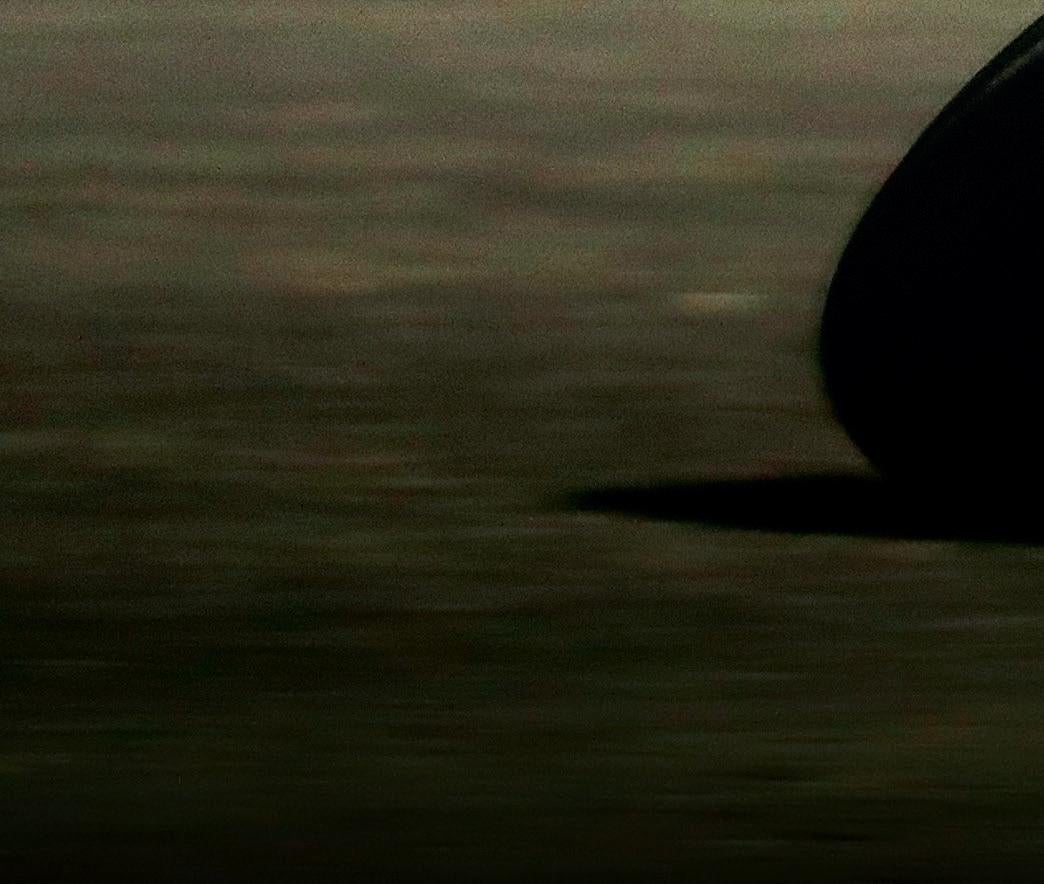

Indian’s FTR750 has been so ruthlessly effi cient since its fulltime introduction in 2017 that, in an effort to level the playing fi eld to some degree, AFT has moved to allow technology few thought would ever be allowed in the sport. Flat track has doggedly maintained antediluvian tech rules to retain its identity, hence no form of aerodynamic bodywork is allowed; twins must have steel frames, not even aluminium is allowed, which road bikes have used since the mid-1980s. Until 2020, everyone was forced to use a tyre tread pattern introduced in 1971. All this goes some way to keeping a lid on development costs, on testing time, on running costs. But now traction control has been introduced and, for SuperTwins teams who feel they need it, their costs could go through the roof as they search for the sweet spot where the systems actually give them an advantage.

Traction control (TC) is monitored by various sensors feeding back to an engine management system (EMS).
The EMS is programmed, usually by a very well-paid technician, to react certain ways under specifi c conditions. For instance, when the speed of the rear wheel is X% quicker than the speed of the front wheel, and while the rear shock and front fork strokes are within certain parameters, retard the ignition or cut the spark to reduce power until such-and-such data set is reached.
The EMS constantly monitors and compares all the information delivered by the sensors, ultimately taking the control of power delivery
Volusia Speedway, Florida, 12 March 2021
out of the rider’s hands and passing it to the EMS and the technician tuning the TC system. Why is it needed? Simply, the smaller-diameter, lighter crankshaft assemblies of the road bike-based engines don’t have the same calming inertia of the FTR750’s largediameter crank fl ywheels, so riders can’t get the same drive on many track surfaces. It’s not simply weight, it’s about diameter and moments of inertia too. A non-Indian twin can make the power, but will spin the rear tyre too easily when the rider wants to accelerate. It’s all fi ne margins, and therefore very hard to tune for.
MotoGP has used ‘rider aids’ like TC since the 2000s and they’re now well accepted by the whole paddock. Which brings us back to Volusia and this photo. The new era got interesting in a hurry when Estenson Yamaha’s JD Beach fi nished the SuperTwins main in second place, behind the Indian FTR-mounted Brandon Robinson. Beach is a supertalented rider, but he’d scored a best



fi nish of eighth the previous season, on essentially the same bike, and that was his one and only top-ten fi nish all year. Still, it was foolish to judge traction control on one night’s racing. It seemed almost implausible to they’d immediately solved the problems that had plagued the team throughout 2020. The next night, same track, different conditions, JD was ninth out of just 12 entries. It’ll be interesting to see if the traction control era will be signifi cant, or just a futile experiment to try to rein in the dominant FTR750.

7
Words: Gary Inman Photo: Scott Hunter/American Flat Track
Words: Sammy Sabedra
Photos: American Flat Track, Sammy Sabedra

Flat Track
I’m certain anyone reading a magazine rooted this deep in the sport will need no introduction to Travis Pastrana, but just in case, his list of accomplishments on both two and four wheels would fill a book and be entertaining as hell to read. Motocross, supercross, freestyle, mountain biking, rally, base jumping, NASCAR, monster trucks… You name it, Pastrana has done it all and done it well, except for that one time at the Daytona short track back in 2006.
Yes, Pastrana tried flat track and came up a bit short on making it out of qualifying in the 60-rider cut. Looking back, his chances of making it had little to do with talent and more to do with the circumstances he faced. To say he was thrown in at the deep end would be a huge understatement. Pastrana showed up riding a completely unfamiliar motorcycle – a Suzuki 450 in a C&J dirt
>>
There are stars and there are superstars, but there is zero doubt which side of the line Travis Pastrana falls on. We followed his foray into American

9
track frame – against the world’s best at one of the hardest places to make an event, even by seasoned veterans’ standards. Just the fact that Pastrana attempted to qualify was enough to earn the respect of the sport and his peers. As an added bonus, he helped silence a lot of critics who reckoned ‘going in circles’ is easy.
Fast forward 15 years to this year’s Atlanta Super TT. The news of Pastrana riding the third American Flat Track round had everyone talking. It seemed as if every time I checked my inbox or answered my phone someone was asking, ‘Hey, did you hear Pastrana is riding Atlanta?’ or wondering, ‘How do you think Pastrana will do?’ There were theories about why he was riding, everything from redemption to a publicity stunt. We were all wrong.
Turns out Pastrana had a bet with his friend, Ryan Sipes, a whole dollar over who could beat who in an AFT race. Sipes, like Pastrana, has a pretty impressive list of accomplishments on two wheels, with wins in the International Six Days Enduro as well as national supercross and motocross, not to mention an AFT Singles win.
The Atlanta race would be much closer to Pastrana’s comfort zone. He’d be riding a KTM 450, a motorcycle he is much more familiar with, not a twitchy, short framer like he’d raced at Daytona. Adding in the TT course was another small advantage for Pastrana, being more like what he’s used to than an oval.



The 2021 AFT Singles class is stacked with talent and good equipment, so making the main would be a huge success. Along with my duties of spinning wrenches for Varnes Racing, I kept an eye on how the day played out for Pastrana.



12:00 Paddock load-in
One thing that surprised me straight away was the team’s pit set-up. Not much was under the Red Bull canopy other than a small KTM carpet and Travis’ 450. I was surprised to see such minimal equipment compared to most teams in the AFT paddock, but what more did the team need for a one-off race?

13:00 Set-up
The media crews kept Pastrana busy with one interview after another, so I took the opportunity to talk to Ron Meredith, Pastrana’s long-time manager/tuner, who handles anything he does on two wheels. As a race mechanic myself, I was interested in Ron’s approach to set-up. To my surprise, he’d had some experience with flat track in the past. I knew after just a few minutes that with this experience, combined with knowing what suits Pastrana, they wouldn’t be far off on set-up.
1 2 3 4 5
14:00 Tech inspection
Ron walked the bike up and went through the process with tech officials, making sure everything was up to the AFT rule book. Along with motorcycle tech inspections, AFT also inspect riders’ safety equipment, helmets, leathers, etc. This is something most riders do themselves, but after a couple of hours of media bombardment Pastrana was resting up for the night’s racing, so Ron walked his gear over.
15:30 Mandatory riders meeting
Most racers would take two minutes to walk to the riders meeting. For Pastrana, that turned into 25-minutes. He stopped every few feet for a photo op and quiet chat with fellow racers, mechanics and anyone in his path. At the meeting, he was just like anyone else and stood alone, paying close attention to what was being said.
16:55 Qualifying
Qualifying at an AFT race is almost as important as the race itself. On a personal level, it’s my favourite part of the day. The pace is fast and the pressure can be immense for riders. It’s a tricky time, because teams are still working towards a good race set-up. Motorcycles can be far from perfect, yet riders have to set the fastest time possible. It’s a good time to measure how good a rider really is.
For Pastrana, this was the only time his face looked focused. He would come in from a session and immediately look at his times. After the first session he was seventh fastest, and I was impressed. Throughout, things were very close and only four-tenths of a second separated the five riders ranked seventh through 12th on the charts. Pastrana was consistently fastest in the second timed segment, which was the transition from tarmac to dirt and over the jump. Changes to the motorcycle were minimal, so I knew the set-up wasn’t too far off.
The biggest difference for a fast time would have to come from the rider. In the last two sessions, he continued to improve and dropped three-tenths off his time. Unfortunately, everyone else got faster too, and Pastrana ended up ninth fastest overall. But qualify inside the ten at an AFT
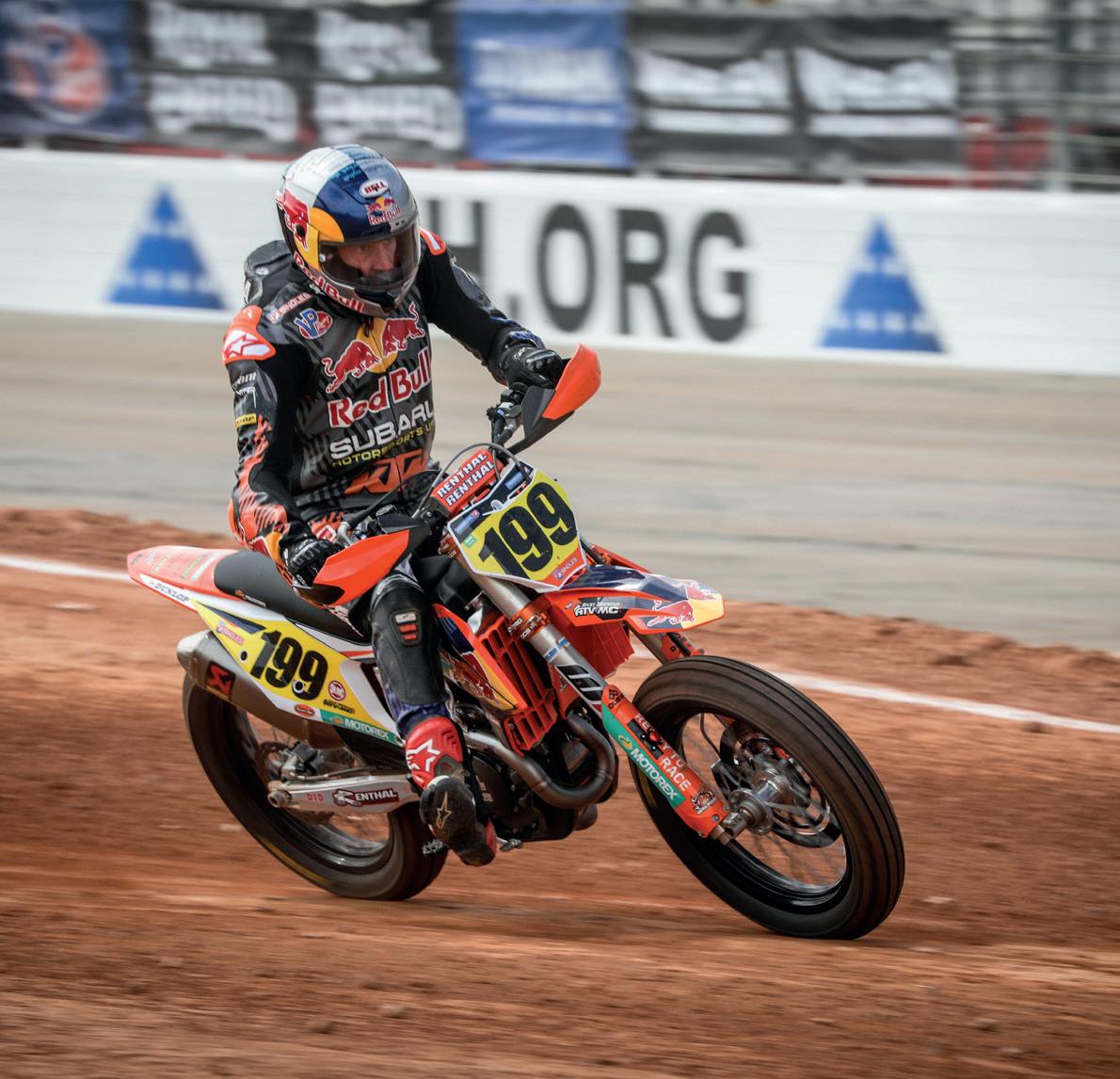
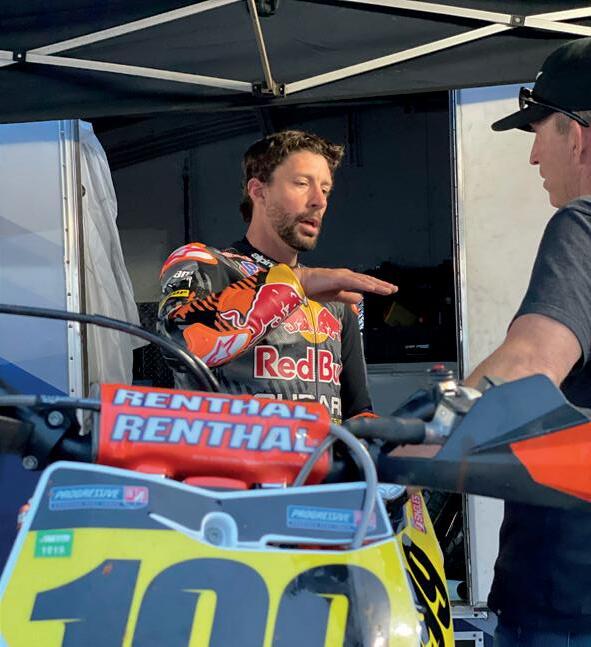

race and you’re in the hunt. >>
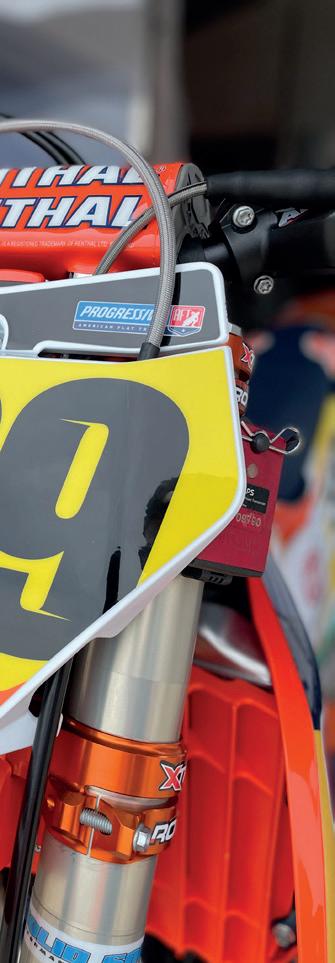 Singles
Singles
6 7 8 9
1. Travis Pastrana has second thoughts about that bet 2. Second flick though. Nope, no mention. Dang 3. Ron Meredith takes Travis’ kit for inspection 4. If the jump isn’t to your liking, make your own 5. See that? Fans. Yep, real people in the stands 6. That plate 7. Getting a feel for the Altanta dirt 8. The KTM 450 was much more familiar territory for Travis than the C&J framer of his last flat track outing 9. ‘Can you see it shaking? It’s crazy out there!’
19:00 Opening ceremonies
With qualifying over, a little time to relax. Pastrana was back to his cheerful, happy-go-lucky self, walking out to the track with a shovel to shape a take-off ramp on the side of the main jump. He’d decided he was going wow the crowd with a backflip in the opening ceremony. And he did. Even cooler, he did it on his race bike.
20:05
Semi #1
It was finally race time. Only the top eight finishers in each of the semis would advance to the main event. With most of the riders so close, a good start was essential. If you lose too much time here, especially on this track, it’s near impossible to make up lost time.
The AFT regulars are used to this, but maybe Pastrana was caught a little off guard by the pace on the opening lap, and not getting the best of starts didn’t help. He’d earned a second-row start, but soon found himself in a fierce battle with American Honda’s Cole Zabala. Zabala ultimately got the better of him and Pastrana crossed the line in seventh, good enough to qualify for the toughest, most contested main event on the AFT roster.
Looking at the charts after the race, I could see his times were consistently fast, especially through the second segment, where he’d been so good in qualifying. Making the main was huge, not only for Pastrana, but for the sport. Anything he’d go on to do in the main would be icing on the cake.
21:15 Singles main event
If you’re lining up for an AFT Singles main event, you are one of the fastest of the fast. Over half the riders in the field were previous winners and the rest were on the verge of their first win. This time, Pastrana looked a little more on pace right from the start. Some of the craziest battles can be found mid-pack and he found himself in the thick of it. He fought his way from from 11th to finish a solid ninth, right behind his buddy, Sipes. After the race, Pastrana said, ‘I saw Sipes in the final, that was kinda my goal, good times. Hey, I made the main – top ten!’
That night in Georgia, Travis Pastrana displayed all the reasons why he’s a superstar. He showed up in grand fashion, made time for all the fans – even if most of them were fellow racers – and proved just how much talent he has. Even if it cost him a dollar.




10 11 13 12
10. On the grid at the cavernous Atlanta Speedway 11. Paddock contemplation. Where to gain an extra tenth of a second on those in front? 12. Floodlights on, tension building 13. Ryan Sipes pipped Travis in the main and plans how to splurge the winnings from their bet
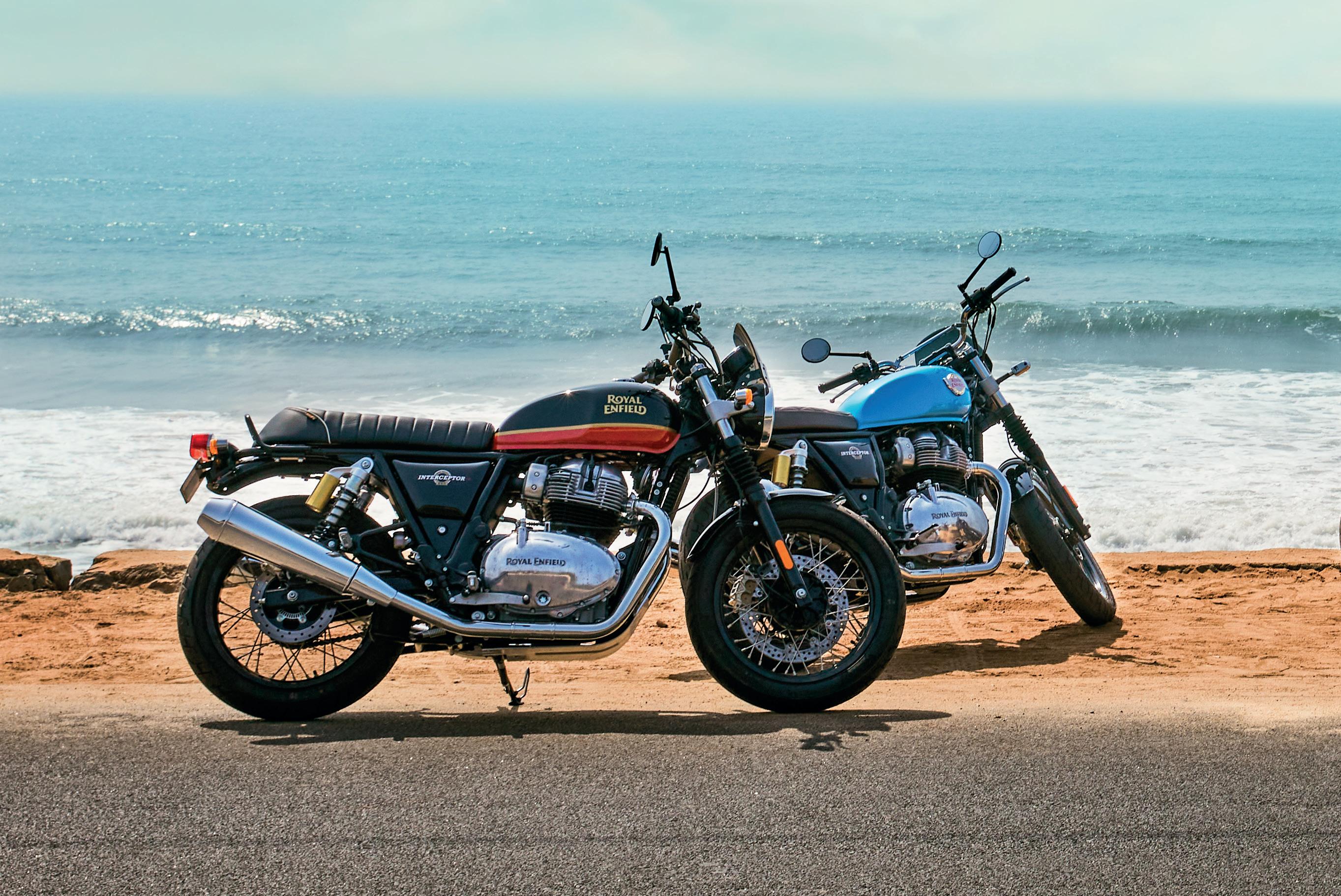














NEXT LEVEL STREET PERFORMANCE.
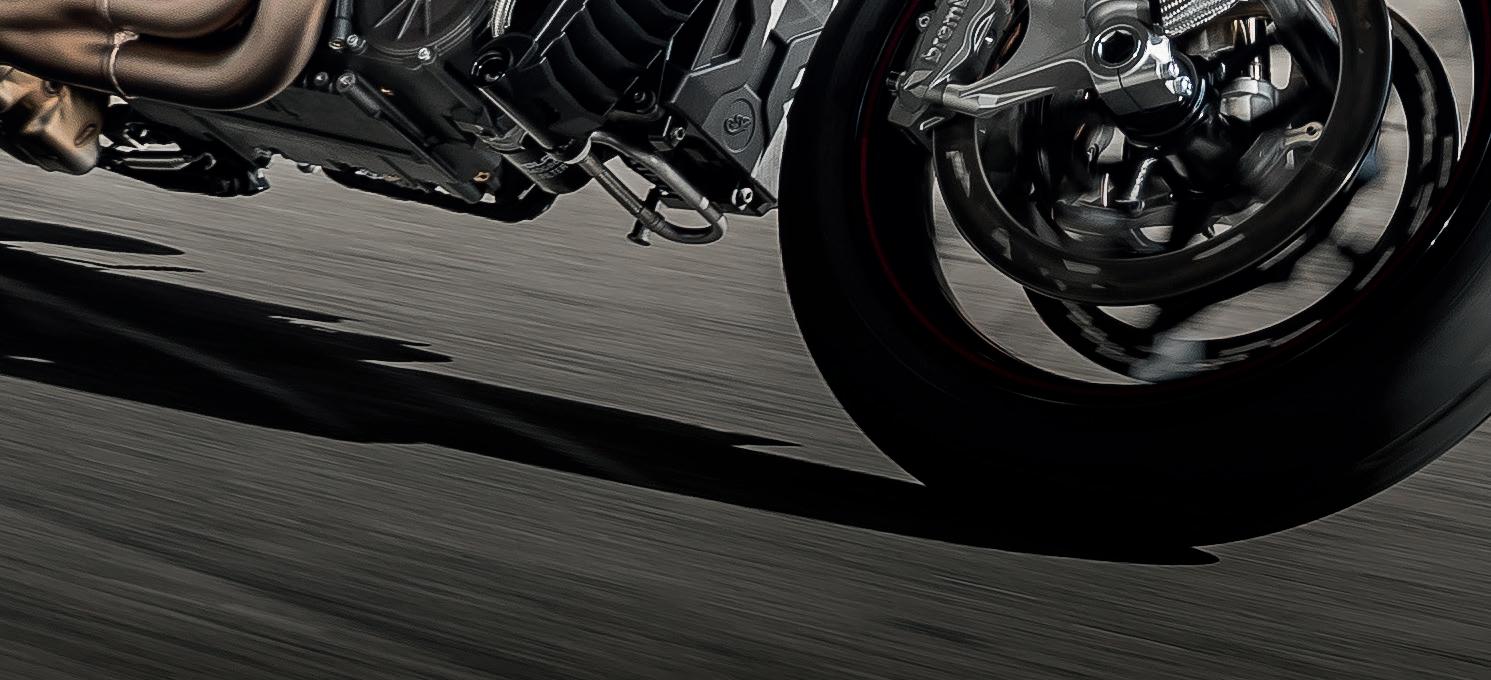




SHOWN: FTR-R CARBON
MODEL
THE FTR ® LEGACY CONTINUES.
A refined engine tune with more urgency, is combined with tarmac-honed suspension and Metzeler Sportec tyres to deliver optimum turn-to-turn performance with new levels of agility and handling. An experience like no other.




 © 2021 INDIAN MOTORCYCLE INTERNATIONAL, LLC.
INDIANMOTORCYCLE.CO.UK
© 2021 INDIAN MOTORCYCLE INTERNATIONAL, LLC.
INDIANMOTORCYCLE.CO.UK
WHO? WHAT? WHEN? WHY? WHERE?
DALTON GAUTHIER
You’re one of the most exciting young talents in American Flat Track, the 2019 AFT Singles champ, but what can you tell us about your first motorcycle race?
Honestly, I’ve been racing for so long, and I started riding when I was two years old with training wheels, so I can’t even remember my first race on a motorcycle, but I’m sure I was at least four. I’m not sure how I did or where it was, which is pretty funny to think. I do know I was on a little badass Honda XR50 with a sweet Hot Wheels graphic kit and a downpipe my dad made for me. My Honda 50 also had a big-bore 88cc kit in it. So to think I was four on an already ‘built’ Honda, that’s pretty awesome.
When did you turn pro?
After going for the Horizon Award1 in 2014. I came up a tad short on winning it in my last year racing amateur. I went on to be pro in 2015, at the age of 16, at one of my favourite tracks on the circuit, the Daytona Short Track next to the Speedway in Daytona Beach, Florida. I was riding for Mike Scott, of Scott Powersports, on 2014 Yamaha YZ450s. I came up with a pair of solid results.
The first night I qualified 28th, just making it into the night show2, then eighth in my heat, which made
APPENDIX
me go to the Last Chance Qualifier [LCQ]3. I ended up winning the LCQ and coming home in seventh for the first ever national I competed in. The second night went a lot better. I ended up winning my heat race and bringing home some hardware with a third in just my second race in the Pro Singles class. And that year was stacked! I wanted to win the race, but we came up a little short on setup for the main event, if I remember correctly. It still felt awesome.
What’s your most memorable race win so far?
That would be the Arizona Mile 2016, when I came from a third-row start on the legendary Ron Wood BMW4 to win the GNC2 main event for BMW’s first ever national dirt track win, my first on a twin, and, maybe, the last person to win a national on Ron Wood’s equipment. But the Sacramento Mile in 2019 is up there too, as I was the first person to win on the HarleyDavidson XG750R. I’m pretty proud of those two.
What’s the best motorcycle you’ve ever raced?
Probably one that I just rode a couple of weeks back. Robby-Bobby McClendon5, my mechanic, built me a sweet Circle F-framed KTM 450 to
play around on and do some outlaw6 stuff with, and, man, that thing is sweet. The handling is nothing like I’ve ridden before. It’s light and feels like you’re throwing around an XR100. It’s nothing but a blast to ride, so that’ll be at the top for me, for now.
And the worst?
I can’t say I’ve ever ridden a horrible bike. I always seem to adapt to whatever motorcycle I’m riding and just go with the flow and it ends up working out for me. I think all bikes are good, haha!
What’s your all-time favourite racetrack and why?
It has to be the Daytona Short Track or the legendary Springfield Mile, but since I have accomplished more at Springfield, I’ll have to go with that one. It’s so smooth, the dirt is unreal. The equipment they use for prepping the track is just awesome and the fans are always in the stands drinking beer and cheering us on, which makes it better. I can’t wait to go back and race there again and try and do another ‘threepeat’. I’ll be on a single for the Springfield Short Track, since I can race the Singles class because they race on a different day to the Twins, and then go race the Production Twin on the mile the next two days7
Interview: Gary Inman Illustration: Madison Ketcham
1. Annual award given to the most promising US amateur racer, in dirt track, road racing and MX categories. Since renamed in honour of the late Nicky Hayden.
2. In dirt track classes with big entry numbers, riders qualify then race in heats to make the ‘night show’, made up of the semis and the final, aka ‘the main’ or the main event. 3. Depending on the race promoter and their rules, some events have one more race for riders who don’t qualify for the main through the semis. A grid of unsuccessful semis riders competes to transfer to the main. Only the top one or two transfer to the main, where they’re on the back of the grid. 4. Ron Wood developed a BMW parallel twin based on an F800. Wood and this bike were featured in SB3. The win came in the GNC2 class, contested by 20 riders on twins. 5. Former racer, current race promoter, Dalton’s crew chief, podcaster, a dirt track polymath. 6. Outlaw racing, nothing illegal, simply US races that are not sanctioned by the AMA. They can be big, with decent prize money. 7. Since this interview, rules have changed (again) and Dallas Daniels raced two classes in the same day at Atlanta.
>>















You’ve moved out of the SuperTwins class after just one year, how does that make you feel and what do you think of the Production Twins class? Moving out of SuperTwins was definitely not in my interests. I obviously want to be racing the best dudes in the sport, but finding a ride and money to fund a race team is so hard nowadays, so I had to move down. The Production Twins class is nothing but awesome, though. There are more riders, more brands and the competitors are still really tough. I’d like to chase another championship this year and hopefully get it done so I can move up and stay in SuperTwins and try and go for three [different titles] which nobody has done yet.









What’s the best thing about being a pro motorcycle racer?
Definitely the fans you get coming up to you, or the messages I get on social media. Everyone is always seeming like they want to see me succeed, some want to help me in any way they can, and it shows how awesome our sport really is. I love racing and I think it’s what I was born to do. If it wasn’t for the fans, I don’t think it’d be nearly as cool. So thanks to them.
And what’s the worst thing?

Probably, that you’re only as good as your last race and I’ve really noticed that, since I haven’t won a race in almost two years now. It’s crazy to think, but it makes me wanna be better and go win even more now than ever.
What would you be doing if things had worked out differently and you weren’t a racer?
Without racing I think I’d either be in college or have a full-time job. As bad as it sounds me saying it, I never wanna be in those shoes. That’s why when I race I always put 110% in and give it my all, ’cause you never know when something can happen and racing can get taken away from you. I hope I never have to work a nine-to-five, because, like I said before, I think I was born to race and that’s why I’m here. I don’t
think I’d be a happy camper without racing. I know I wasn’t in 2017-2018!
Those are the years you were banned from racing, because of a positive drug test, and had to do AFT’s ‘Road to Recovery’. It seemed to take longer than it should to complete, why? When I first learned about the drug testing failure it was heartbreaking, and I definitely don’t think I should’ve got the flack that I got. But we live in a crazy world nowadays, with social media, and I definitely received a lot of backlash from people, as if I was addicted to drugs or had a drug problem, and that definitely wasn’t the case. But I was young and just being dumb.
Taking two years off was my own personal idea. I wanted to take a break from racing and just be a kid and do regular things that I didn’t get to do while I was racing around the country. I feel like my time away from racing actually made me better, and it showed me a lot of things about life. I think I came back faster, more motivated, and with a different outlook on everything. It might not have been the best idea to take those two years off, but I think it’s what I needed. Crazy as it sounds, I wouldn’t take it away. I feel like everything happens for a reason and I live by that. I was still riding, but not nearly as much as I do now, and I wasn’t getting the joy out of it, ’cause I wasn’t racing. Also, I think I’ve grown a lot bigger fan base ever since the drug testing thing happened. People can say what they want or think whatever about me, but I put that stuff behind me and I just go have fun and race my motorcycle, ’cause it’s what I love to do.
Who is the toughest competitor you’ve ever had to face?
It has to be Briar Bauman, even though I didn’t get to race around him much. I really like the way he goes about things and his racecraft. We could talk all day about it. Also Jared Mees. Just when you think that guy is struggling, he’s firing back and his work ethic is second to none.

If you could change one thing about AFT, what would it be?

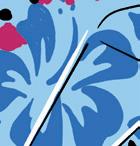




Probably track prep. Nothing against AFT, they run a great programme and make our sport happen when nobody else is doing the same thing, but sometimes we need better tracks or prep and the racing would be a hundred times better.
We have $1000 to put on the AFT Production Twins class, should we put it on 79?

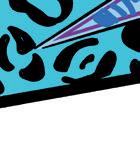
Sheesh, that makes me want that championship even more and I’ll def be gunning for it at every race, just like in 2019. Like I said, 110% every time I’m on the track, so I think it would be a pretty good bet... #79 for the dub!
What would you need to be able to win the SuperTwins #1 plate in your lifetime?









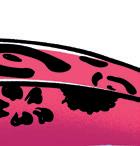
Honestly? A good team, good people around me, good training programme and diet. And riding a lot and having good bikes under me. That’s why I’ve stuck with team Vance and Hines for the last two, three years, because they always put 100% effort into me and my programme and help me in any way they can. I can’t see myself with anyone else right now, I’m happy to be working with the Vance and Hines crew. Our focus is the Production Twins championship at the moment, but I’m sure once we get all our ducks in a row we will be a force to be reckoned with in the SuperTwins class.


In the thronging Dirt Track Riders Association pits, friends form different packs. Most of these cliques didn’t know each other before the individuals began racing, but firm friendships have been cemented. Other racers sit alone for any number of reasons.


But whether alone or in groups, at this level of keen amateur to borderline pro, many riders see racing as more of a social event than a cut-throat motorsport. For many, it’s golf with a 50mph corner entry; five-a-side football with the real risk of a collarbone-cracking highside; a neighbourhood basketball game with body armour. There are fast riders on their way up, perennial also-rans, some backmarkers, and a handful of dogs who can have their day, but the one thing that unites nearly all of them is the skirrssshclonk hot-shoe march they do to the track fence when the Hooligan class is in action. For the rest of the day they have bikes to tweak, drinks to down, tanks to fill, bladders to empty... but when the Dirt Track Riders Association (DTRA) hooligans are going at it, the rest of the pits are watching. They want to see the liberties the head of the field are taking with heavy street bikes on a track they themselves have just competed on in a heat race. The whole of the pits want to witness how late they dare brake, how hard their passes are, how much lean they have on when sliding towards the apex. They’re not a class of attention











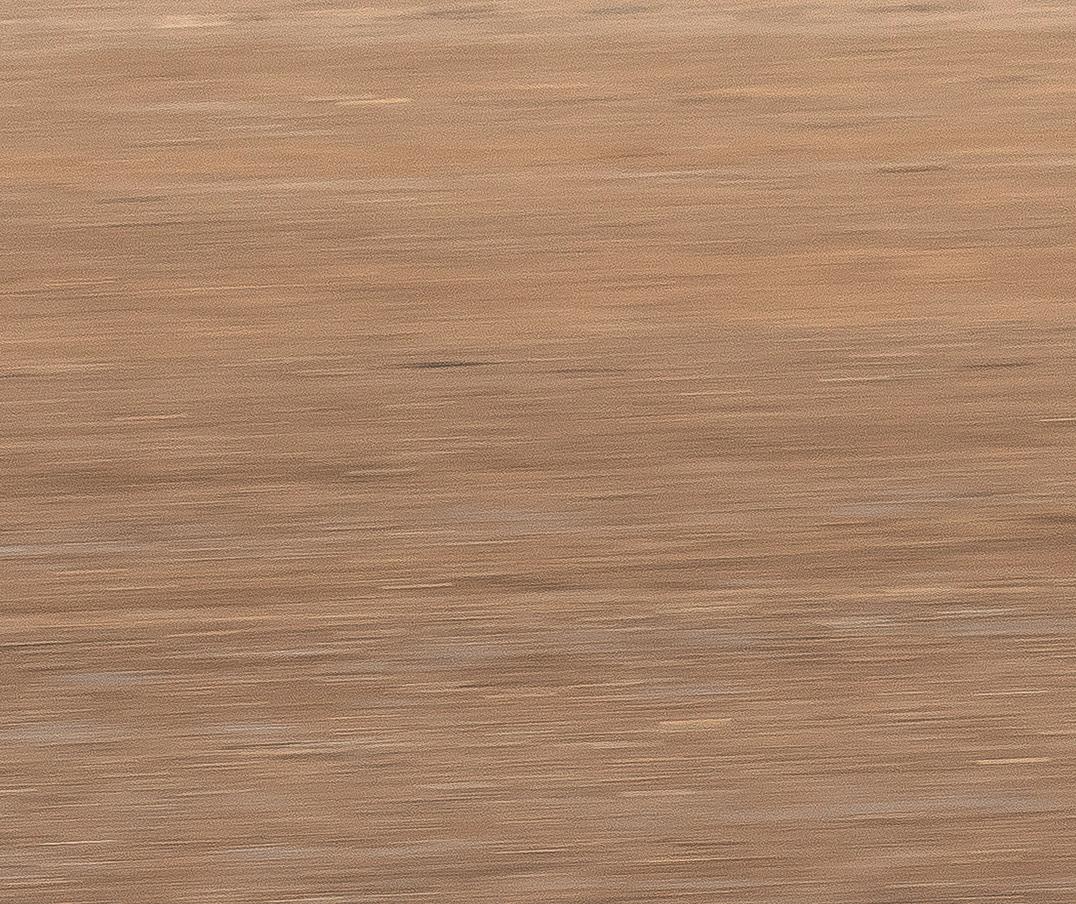
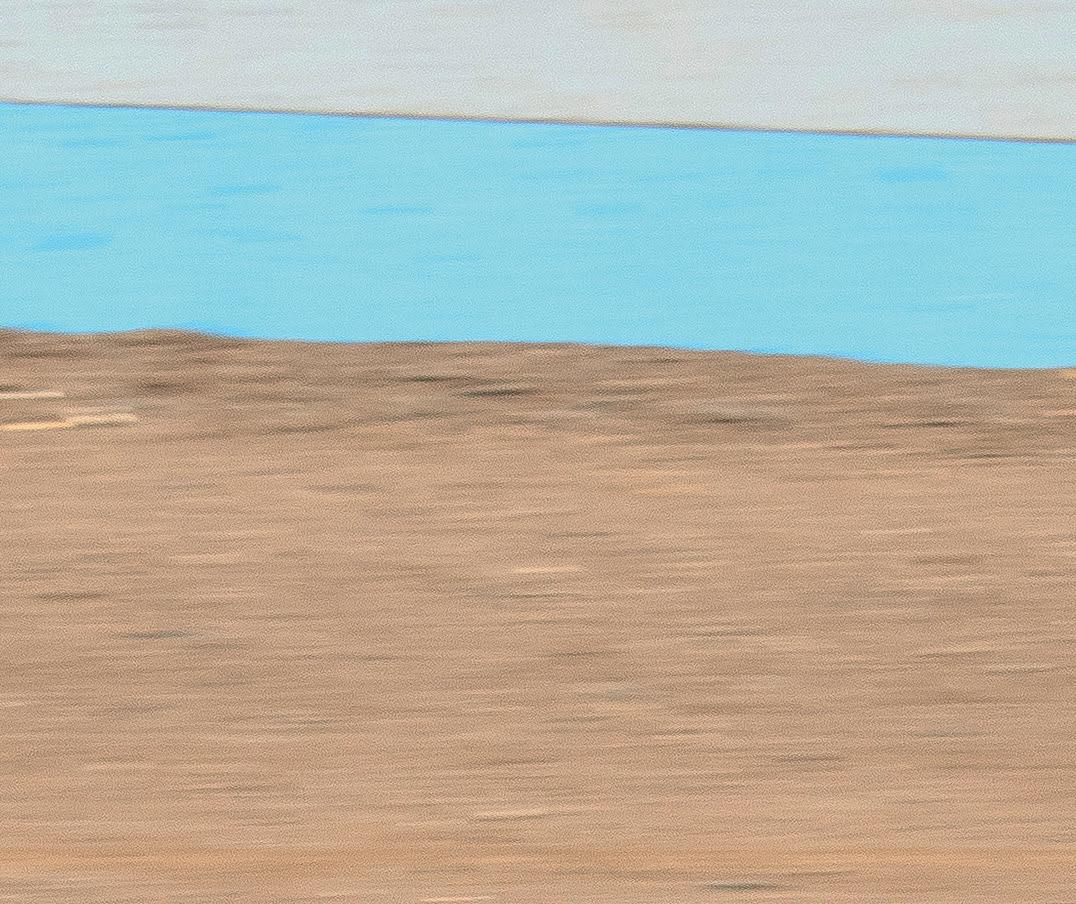

pits Between
luring riders from the races, but a fix of Brawling hooligans always draws them to the track fence
>>
Words: Gary Inman Photos: Braking Point Images

















21
seekers thinking about social media likes, they’re racing on the edge.
The DTRA’s Hooligan class has developed rapidly. Launched in 2016, there was a handful of Harley twins, a street-legal Ducati Scrambler and a Yamaha YZF750 on road racing wets, plus, before long, the Krazy Horseprepared Indian Scouts. Some of the bikes still had their lights fitted, covered in tape. Within a couple of seasons there was a Bike Shed/Ducati UK Scrambler that cleaned up with Gary Birtwistle on board, a pair of big-budget S&S Indian FTR1200Hs, and another couple of wellridden Ducatis. The Hooligan class became the de facto Pro class. The DTRA does have a Pro class, but all except one of the frontrunners in Hooligan are contracted riders on manufacturer or dealer bikes, where the majority of the Pro class are riders on their own DTX 450s, paying for racing out of their own pockets.
Jack Bell is both a hooligan for hire and Pro class racer. The 17-year-old trainee construction worker is signed to the Devitt Insurance Vanoni Moto Officina team to race their new Ducati Scrambler. This is the second Ducati hooligan built by London-based Max Vanoni for the DTRA. ‘In 2018, my friend Giovanni Beliossi, asked me if I’d like to come look at the races that he was taking part in,’ he says in his broad Italian accent. ‘I went to Greenfield with him and knew it was something I wanted to get involved with.’
Originally a chef, Max made the switch to motorcycle customisation and
building ten years ago. His background is street bikes, with a special attachment to Ducatis. He worked with DMOL, Death Machines of London, building crowdwowing show bikes, and the thought of building a race bike that would leave everyone in no doubt that both Max and DMOL could build motorcycles intended to be more than beautifully crafted ornaments, was strong.
Max found himself at a London motorcycle show, where he’d taken some DMOL bikes to cause a stir in the booth of UK insurance company, Devitt. At the same show, the godfather of UK flat track and former UK Pro champ, Peter Boast, was running a minibike indoor flat track series. Before the weekend was over, Max had a plan. He and Devitt’s marketing director, Tom Warsop, had decided they should build a hooligan, and they’d enlisted Boast to race it.
Tom Warsop explains why they were so keen to get on board. ‘As motorbike insurance specialists for over 85 years, Devitt have always supported a range of motorcycle sport, from tracks to roads. We already had an interest in flat tracking and always enjoyed Dirt Quake, so when our friends at DMOL spoke to us about their new project with Pete Boast as the rider, it was a no-brainer for us to get involved. We knew Max would build a great bike and Pete was a legendary rider, plus we love to support fun and interesting motorcycle projects. Entering the flat tracking world felt like an exciting place to introduce Devitt to a new audience too.’

Below: Custom adjustable triple clamps, DLC fork stanchions, pullback risers, NK Neken Jared Mees handlebars; ‘If you can grow them to this size, we have a chance of winning,’ Max Vanoni gives Jack Bell a training target Opposite: SC Project exhaust kindly gets out of the way so we can see the one-off swingarm. Vanoni designed the rear disc and caliper hanger after teaching himself CAD in lockdown. Custom Öhlins shock is from BG Motorsport >>

‘We knew Max would build a great bike and Pete was a legendary rider, plus we love to support interesting motorcycle projects’



Above:The Scrambler is tall for a dirt tracker, but then so is Jack Bell. After a winter of tweaks to bars, brake lever and seat, the hooligan fits him perfectly; Max’s contacts with Urban Rider ensure Jack takes to the track in fresh custom kit
Left: Racing two classes in one day can get, er... tiring
Easy, right? Er…
The bike Max built for 2019 is what he now refers to as the ‘prototype’, and, he believes, the carbed engine was both too powerful for the UK’s short tracks and not as easy to tune as a fuel-injected engine. Boastie struggled to get to grips with it at first, and even when he did, ‘Coming third was like winning for us,’ says Max. With Devitt still on board, and just as Max left DMOL to set up his own workshop, Vanoni Moto Officina, in partnership with UK motorcycle apparel experts Urban Rider, it was time to start again. He bought a crash-damaged 2016 Ducati Scrambler Urban Enduro and went back to the drawing board.


Hooligan rules demand the frame and engine be from the same bike, that the engine must be in excess of 750cc, and that the main frame cannot be modified. Beyond that, Max got to work. The front end was replaced with the flat tracker’s go-to – early Yamaha R6 conventional forks – with DLC-coated stanchions, held in one-off Italian IMA triple clamps.
Max ditched the stock tank and created a four-litre fuel cell under the seat. He then made a one-piece dummy tank and seat unit from fibreglass, that allows the rider to move closer to the bars, and is much narrower, making the V-twin feel more like a 450. This is the second version and is more slender than the first, with more padding.
swingarm. ‘You have to take too much metal out of the Ducati cast aluminium swingarm to get a 19in wheel to fit, and then you don’t have much chain adjustment.’ The Vanoni replacement allows for a shorter wheelbase, though Max says current rider Jack Bell prefers a longer wheelbase than Peter Boast did. The new adjusters are designed to be long enough to add exactly a link’s worth of adjustment at both ends, on top of what the original Ducati swingarm gave, allowing for quick chassis tweaks. It was fabricated for Vanoni by a contact who makes Norton Featherbed replica frames.
One of the reasons the other racers crowd the fence to watch the hooligans scrap is the realisation of just how much weight is being thrown around. The Scrambler is significantly lighter than a Sportster or Indian, but Max was determined to lower it further with an Antigravity lithium battery, plastic 796 timing belt covers and by turning down every fastener on the bike to have a shallow head. ‘I like doing things like that,’ Max admits. He also replaced the cable clutch with a hydraulic one (even though the clutch is only used at the start). Max says the original actuator wears, so it was worth doing.
As Peter Boast decided to retire from racing, he recommended his fellow Lincolnshire rider, Jack Bell, to take over the bars of the Devitt hooligan, despite the young rider only having just moved out of the DTRA’s junior classes. Because of… well, you know what, the DTRA only
The 19in SM Pro rims were laced to the original hubs by Central Wheel Components while Max designed a new >>
‘One of the reasons racers crowd the fence to watch the hooligans is the realisation of how much weight is thrown around’
held one race in 2020, and Jack came in second behind two-time Hooligan champ Gary Birtwistle on another Scrambler.
‘At first, I wasn’t too sure if I wanted to race hooligans,’ says Jack, ‘but I rode it at a practice at Greenfield and fell in love. You can’t throw it around like a 450, so I’m working on my fitness, and I’m still learning on the bike.’





Devitt’s Tom Warsop is excited to have Jack on board. ‘He’s a talented young rider, we can’t wait to watch him progress as his experience and confidence grows.’









Second in his first race, and now reigning champ Birtwistle will has left to race for Royal Enfield in the new DTRA Twins category, Jack will make a big impression. I’ll be watching from the fence, with every other DTRA racer.






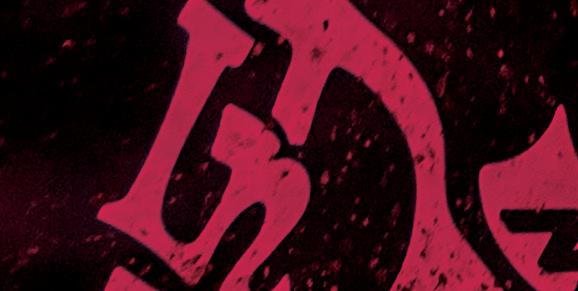

















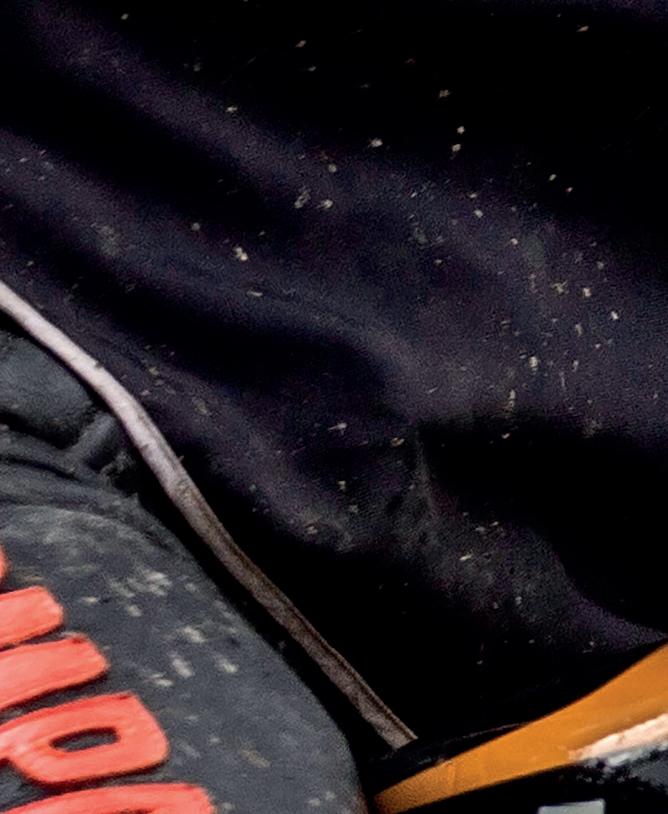

Until recently, no one knew anything about flat track in Russia, it’s nowhere near as popular as speedway or motocross. This race, Motul’s In Dust We Trust, has been held only twice, both times in Moscow, and they are the only two flat track races ever to take place in my country.





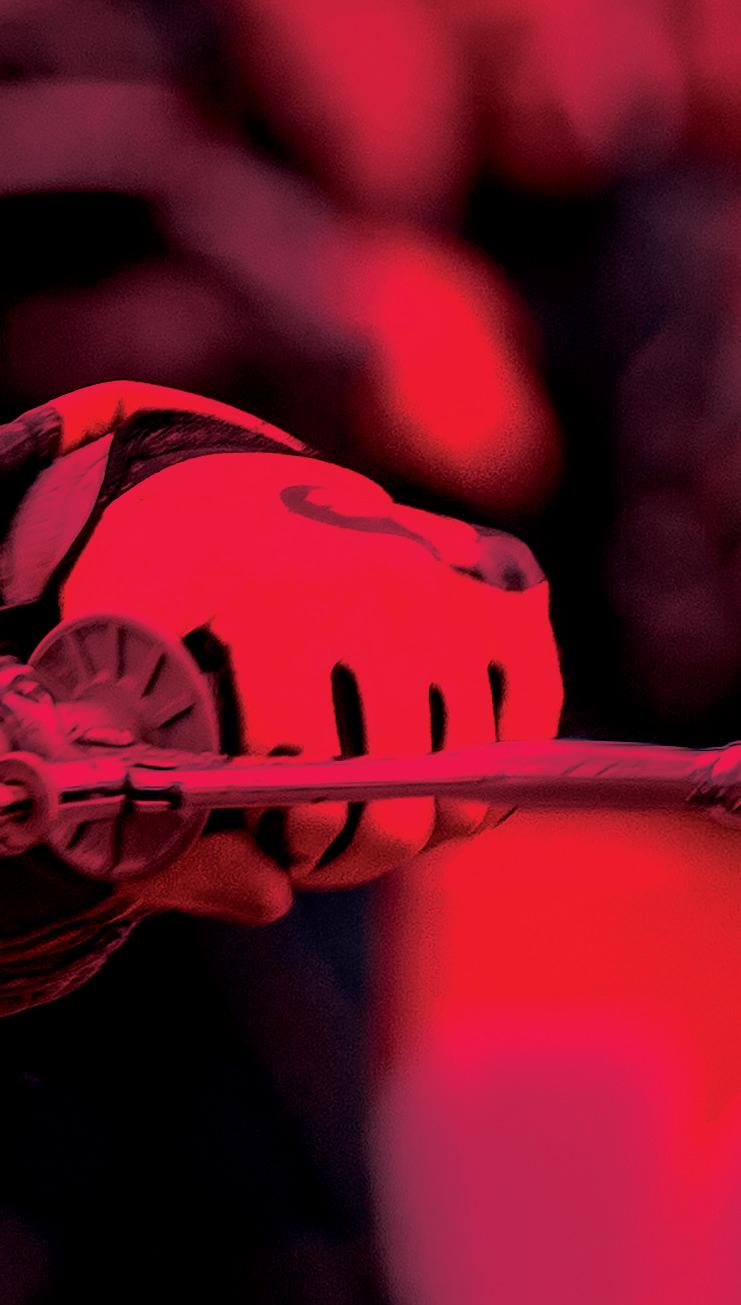
The idea for the event came from Anton Malyshev, director of Motul Powersport and Motul Russia. He is well acquainted with Roland Sands, has been to SuperHooligan races several times, and even raced flat track in America. He also attends Wheels and Waves and communicates with riders all over the world.

MOSCOW
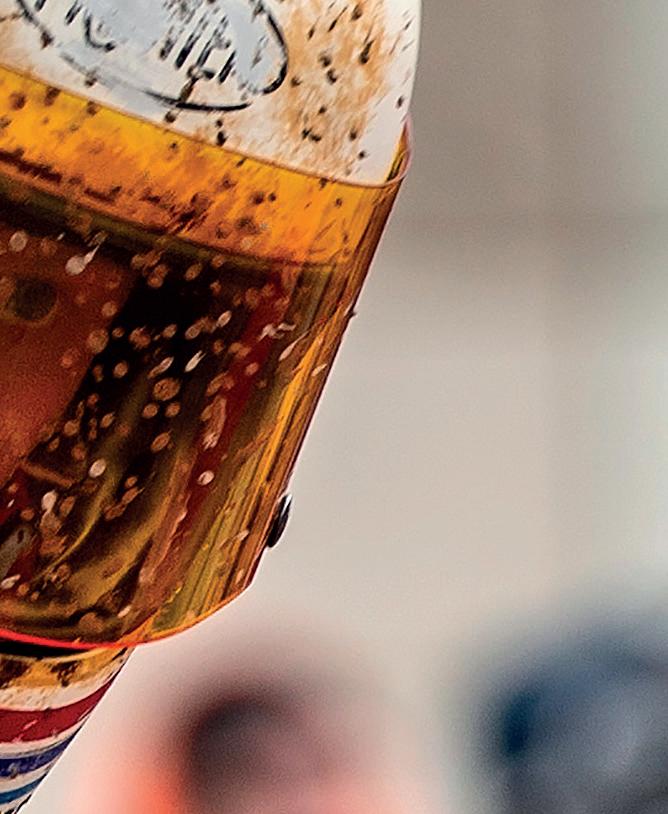




Flat track in the Russian capital
Participation in the Moscow race was free, because Motul took over the entire organisation and costs; all racers had to do was comply with the technical regulations. The event had several classes. The biggest was the Sporty class, for motocrossers on wets or flat track tyres. There were also categories for scooters, Harleys, pit bikes, and, of course, custom bikes. Due to the low popularity of the sport, and lack of information, we only have a few custom flat track or street tracker bikes right now: my Kawasaki W650, built by Iron Chain1 , the Trackmaster Triumph Bonneville and the IZH Planeta From AnkerCo2, and the
 Words: Aleksei Kalabin
Photos: Natali Kapralchik, Vsevolod Rozhok
Words: Aleksei Kalabin
Photos: Natali Kapralchik, Vsevolod Rozhok
>> 29
APPENDIX: 1 Iron Chain’s SR400 street scrambler was featured in SB39. 2. AnkerCo’s gorgeous Trackmaster and Russian IZH two-stroke racer were in SB42.
Building a custom motorcycle is quite expensive for many, and there are practically no tracks to train on in our country. Currently, we have only one oval that we can use, and it is located far from Moscow. It is also very difficult for us to find the right tyres and parts, almost everything has to be ordered from Europe or Japan. Plus, there is only one workshop that can make special hot shoes. But we will definitely develop this sport in Russia.
My experience at El Rollo, and photos published by Capital Wheels – the custom and classic motorcycle community group I run – as well as what AnkerCo are doing, inspired Motul to put on the first flat track race in Russia.
El Rollo, at Wheels and Waves in Spain, is the only dirt track I’ve competed on, and the event in Moscow is difficult to compare with that. We have a very small track built on empty asphalt in two days. Instead of soil and dust, we use granite chips and quartz sand, just like they do on motoball tracks in Russia. The purpose of this event is not primarily competition or high speed, we want to introduce Russian guys to the sport and show almost everyone can participate in it.
After the second In Dust We Trust, many people were seriously interested in this class of motorcycles and the type of racing. Now Motul and our team are preparing several outdoor camps, the construction of our own track and possibly the opening of a school.
It will take a few more years before we can make a fully-fledged festival similar to
Wheels and Waves, but I have long dreamed of inviting many friends to our country. While this whole culture is slowly gaining momentum, there are many guys and girls who love custom bikes and travel to motorcycle festivals in Europe. This year, we want to do something like a flat track on the ice of Lake Baikal3 during Baikal Mile Ice Speed Festival. I really hope that the friends I have made in Europe can travel and we can meet in Russia.
APPENDIX
3. Lake Baikal is the largest freshwater lake by volume in the world, containing around 23% of the world’s fresh water. The Siberian lake has a surface area larger than Belgium or Hawaii and hosts a Bonneville-style speed week when it is frozen.
1. Moscow Polytechnic’s electric motorcycle embarks on its first dirt track rip 2. The twisted Evolution skyscraper forms an incredible backdrop to the race 3. This article’s author, Aleksei of Capital Wheels 4. We do 5. ‘Can’t talk right now mum, we’re just about to plough into a crowd.’ 6. Putting the ‘track’ in street tracker 7. This rider seems to have got the hang of the new discipline 8. Sportster in the bales and a crowd craning their necks for a view of the imported sport 9. Minibikes under the gaze of oil pipeline company HQ 10. I spy someone coming in hot. 11. Race. Face 12. Aleksei and his custom Kawasaki W650 hugging the inside line 13. This move is called the Dead Fly



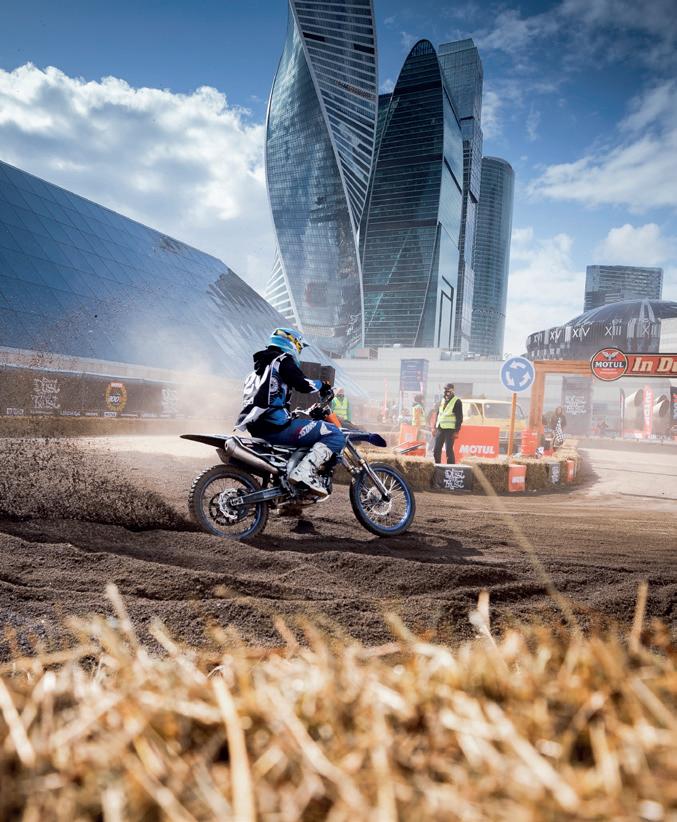
 Yamaha SR400 of our friend Misha from Phlegethon Moscow.
Yamaha SR400 of our friend Misha from Phlegethon Moscow.
1 2 6 11 10









3 7 12 4 8 13 5 9








His ’n’ Hers




>> 35
AWARENESS
It was 2005, 16 years ago, that Short Track UK launched a full season of flat track racing in the UK. Before that, there hadn’t been a single dirt track race on the whole continent since a short-lived, but significant, Italian dirt track series that folded in the 1990s. At the time, very few motorcyclists, outside the USA at least, knew about the sport. Now, for dozens of different reasons, I’d argue the majority of active road riders know a little about dirt track and the style of bikes that compete in it. The sport has been introduced not only to countries where it had absolutely
no previous history, but also to new generations. Teens and 20-somethings in Jakarta want to go fast, Muscovites are turning left (see p28). And Uwe Kostrewa of Hombrese Bikes in Cologne (Koln), Germany, wants to as well.
‘I think the style of flat trackers is simply beautiful,’ he says. ‘I started riding when I was 13 on a Honda Monkey, after that came enduro, supermoto and motocross, all as a hobby rider. In 2012, I built my first café racer, then, after building a few more, I found my way to street trackers.’

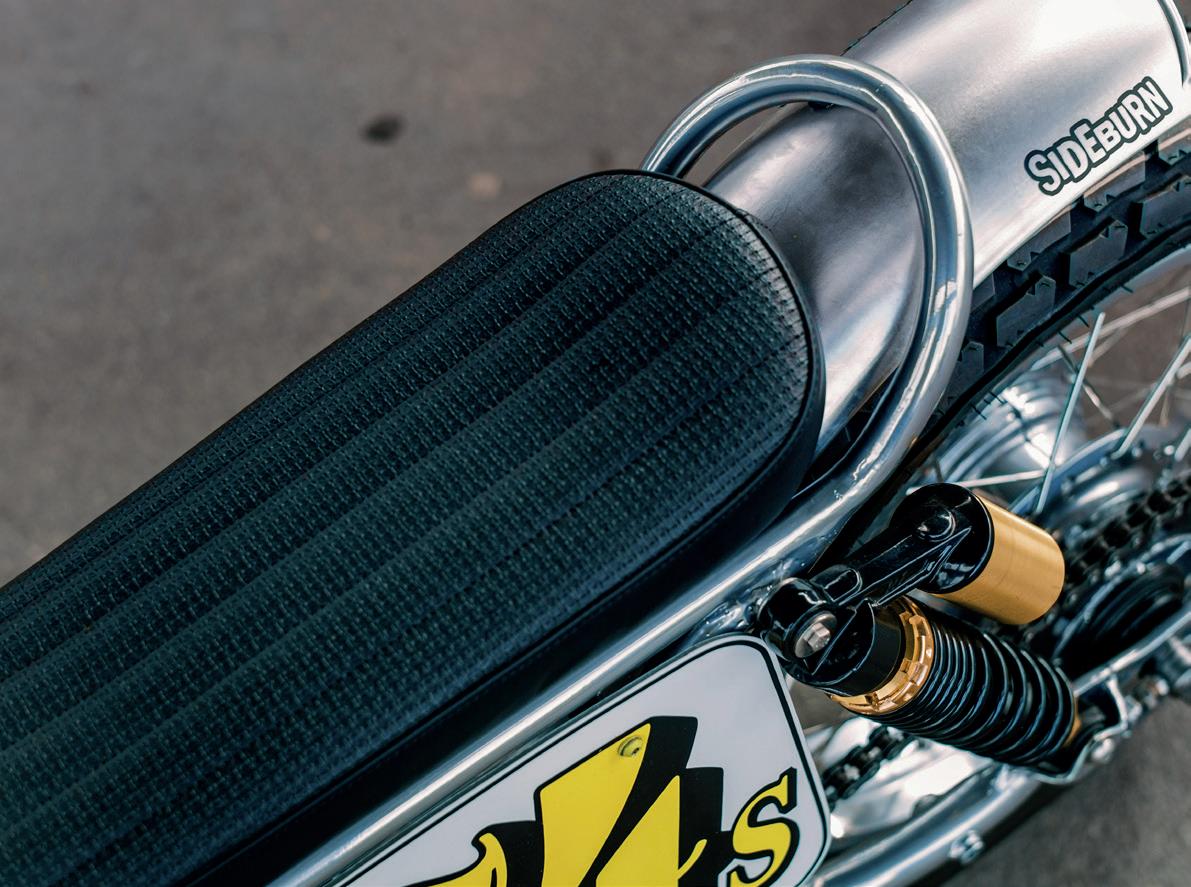
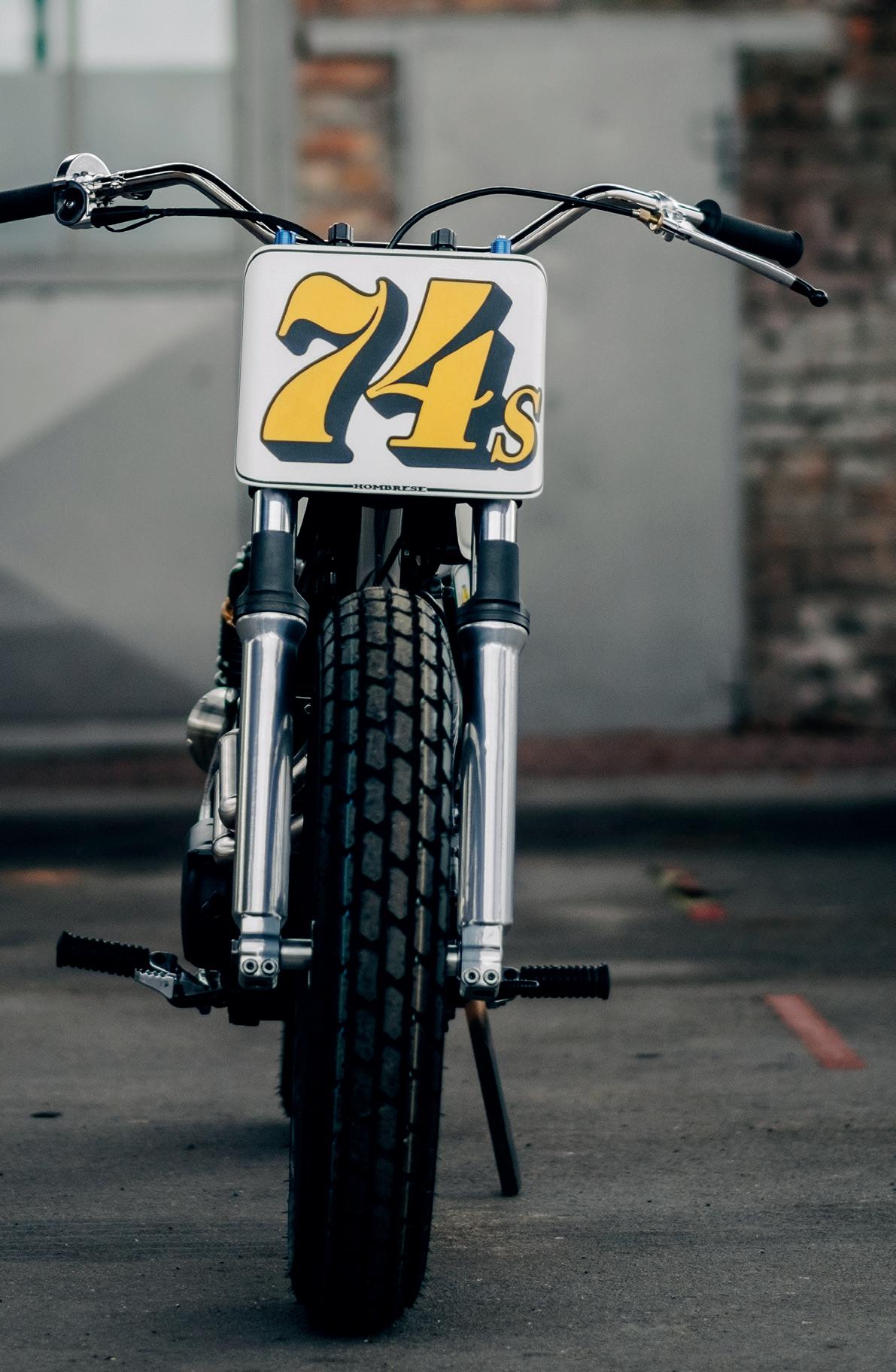
Hombrese is not a full-time, commercial operation, but a private garage that Uwe (pronounced Oo-vah) runs to

build bikes for himself and his friends. ‘In 2018, a friend asked me if I would like to convert his Yamaha YZ450F and he suggested doing it in the flat track style. I said yes immediately. He raced it at Punks Peak1 at Wheels and Waves, and at the same event I competed in the El Rollo flat track, my first experience of dirt track. It was a blast.’



This awareness leads to…
OPPORTUNITY
Uwe learned of Dirt Track Lelystad, near Amsterdam, three hours away in the neighbouring country of the Netherlands,
who were running try-out days, as well as races. Lelystad is a speedway track that was in disrepair until a couple of Sideburn readers took it over and changed the focus from speedway to flat track.

In addition to the Netherlands, there are now race series running in France, Italy, Germany, more than one in Spain, three in the UK, plus races in the Czech Republic. There’s a dirt track organisation in Switzerland and a ‘world’ series run in mainland Europe by the FIM.
It’s not all good news, though. After complaints of noise at some historic UK speedway tracks affected their viability >>
to run as a business, they are closing at an alarming rate and the land bought up by developers. Still, on the whole, the European dirt track scene is growing, with no signs of slowing down, and we haven’t spoken about the resurgence of grassroots dirt track in Japan, the growth in Argentina, Brazil, India and Indonesia.
But it’s nothing without the right…
ATTITUDE
Signing up to race a motorcycle used to feel a lot more intimidating than it does now, at least in Europe. The

USA had an early-’70s On Any Sunday boom of minibikes, small capacity Japanese scramblers and a thousand local dirt tracks running three times a week to dip a toe in. Europe was different. It felt more of a specialist pastime for experts and those in the know. Not exactly a closed shop, but difficult to make a debut without the help of someone already on the inside.

Uwe’s partner, Steffi Schumacher, travelled with him to a track Uwe and his friends had rented for a private test. ‘I was curious to ride on the track myself and it was amazing,’ she says. ‘My first experience was riding a Sunday2.’

,THE FOLLOWING SATURDAY WOULD BE MY FIRST EVER RACE,
It was also the mother-of-three’s first time riding a motorcycle for many years. Uwe was going to compete in the German Krowdrace event the next week, and Steffi immediately decided she wanted in, too. ‘The following Saturday would be my first race ever, and without any experience or training. Of course, I wasn’t on the podium, but I made it into the final.’
Events like Dirt Quake, and the way photos of all types and ages of people racing have been shared on social media, have helped give people the confidence to get involved. They’ve seen young girls and old guys jump on race bikes


for the first time and think, If they can, so can I. Organisers are welcoming too, so it doesn’t feel like a secret society. Also, short track racing, while it can be dangerous, is relatively low speed, can be affordable, and rookie classes are growing.
‘I love the community,’ says Steffi. ‘The people are really great. It’s like a big family, where the only thing that counts is having fun. When I’m on the racetrack my head is completely clear.’
Feeding off Steffi’s enthusiasm, Uwe decided to build this pair. ‘I had a KTM 450 that had too much power for me to >>

learn this sport,’ says Uwe. ‘I am not 18 and my bones need more time to fix now.’
The local dirt track series, Krowdrace, has rules that allow any bike built in 1979 and earlier to compete in its vintage class, so Uwe chose to start with a Yamaha SR500 for himself and a Honda XL500 for Steffi.

‘The SR500 has a very thick frame top tube. There aren’t many tanks that fit right away, but I wanted a DT tank, so it had to be adapted. I did this with the help of a good friend, Michael. The other challenge was installing a disc brake at the rear after the frame and everything had been painted. Since I didn’t want to have the swingarm coated again, I had to construct something that fits plug-and-play into the swingarm. I took a motocross rear wheel and used the Talon hub and the spokes, that way I’ve retained the classic, high-shouldered rim. Since I didn’t know which motorcycle the rear wheel was from, I started looking for suitable brake calipers and mounts. I found the KTM LC4 was what I was
looking for and took the components and made spacers to install the rear wheel.’
Uwe is most proud of the exhaust he made for Steffi’s Honda, and says, ‘I was able to reduce the XL500’s weight to 112kg (247lb) and got my SR500 down to 121kg (267lb). The two engines are still original, but they run superbly.’
Finally, I ask Steffi if she will race her Honda. ‘Of course I will race,’ she replies. ‘At first I was very nervous about the starts, but that is now the part of the race I love the most.’
If you’re reading this and want to race, but don’t know if you have it in you, hopefully this will tip the balance. You have the awareness, opportunity and attitude.
APPENDIX
,I WAS NERVOUS ABOUT THE STARTS, NOW THEY,RE THE PART I LOVE MOST,
1. Punks Peak is the Wheels and Waves festival’s tarmac twisty sprint in the Pyrenean foothills of northern Spain.
2. Sundays are mini dirt trackers with 14in wheels and 140-190cc engines, made in China, and gaining in popularity around the world.



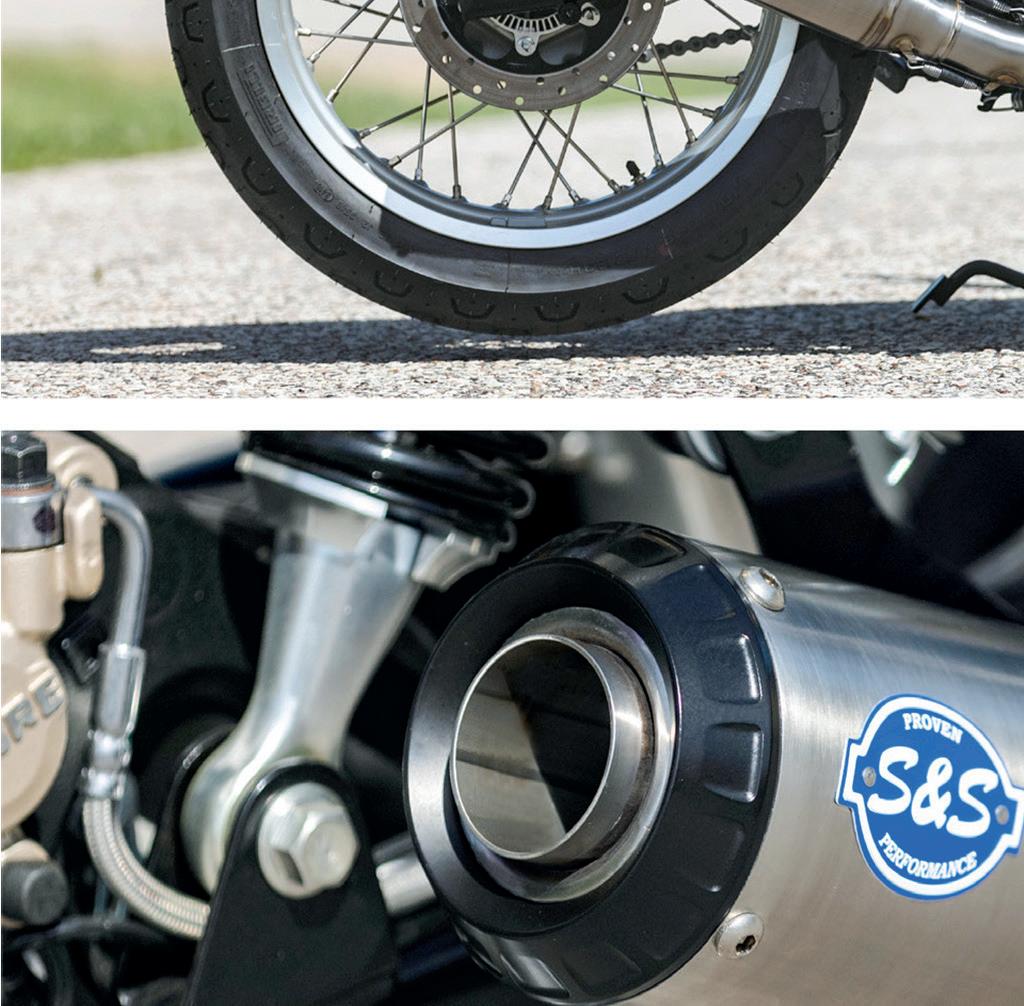




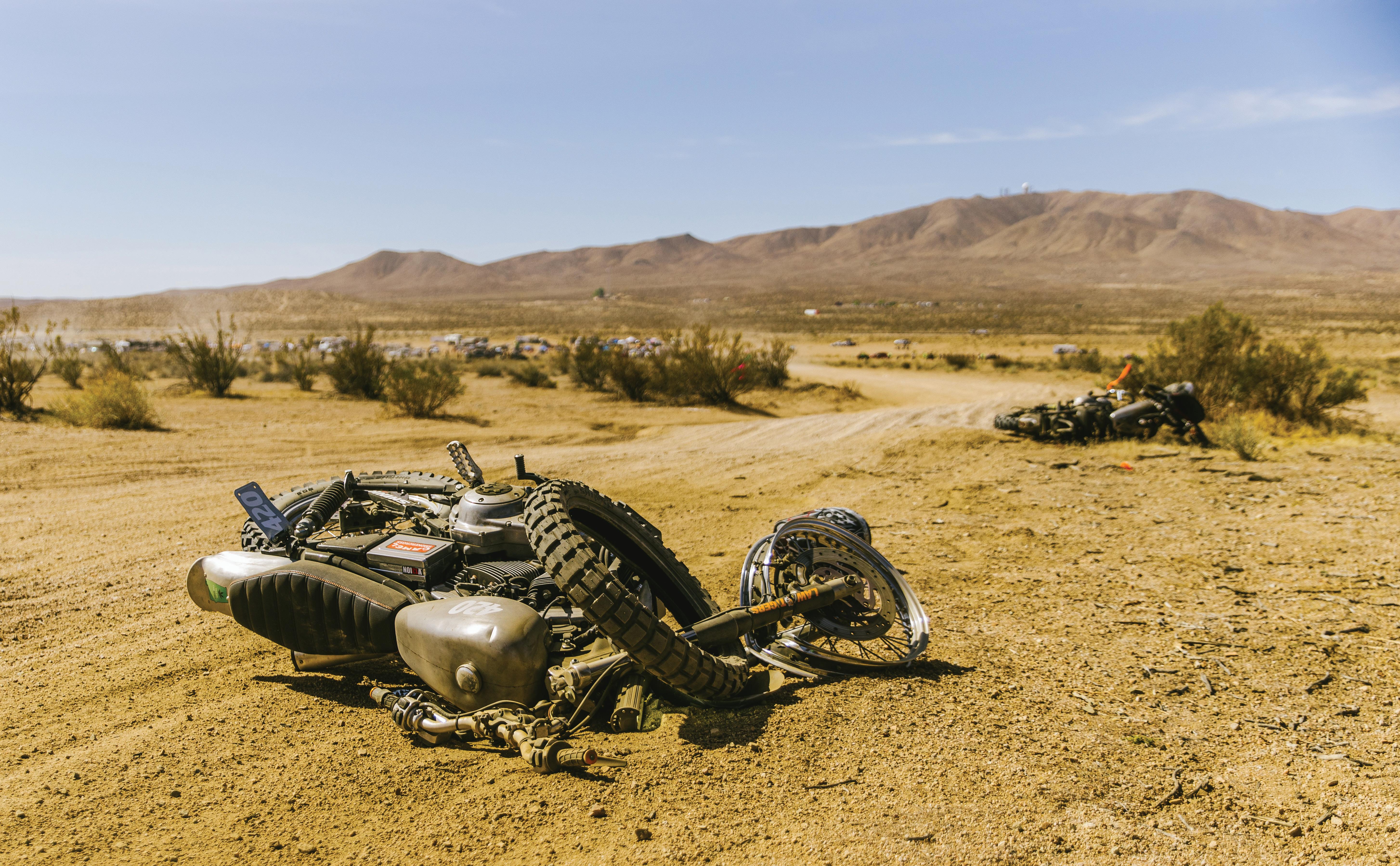
 PHOTO: GREGG BOYDSTON
PHOTO: GREGG BOYDSTON
TURN ONE.
It’s all fun and games until you eat shit in the dust. Thanks to Jason, Cliff and everyone else who survived the 2021 Biltwell 100.


WWW.BILTWELLINC.COM
@BILTWELL






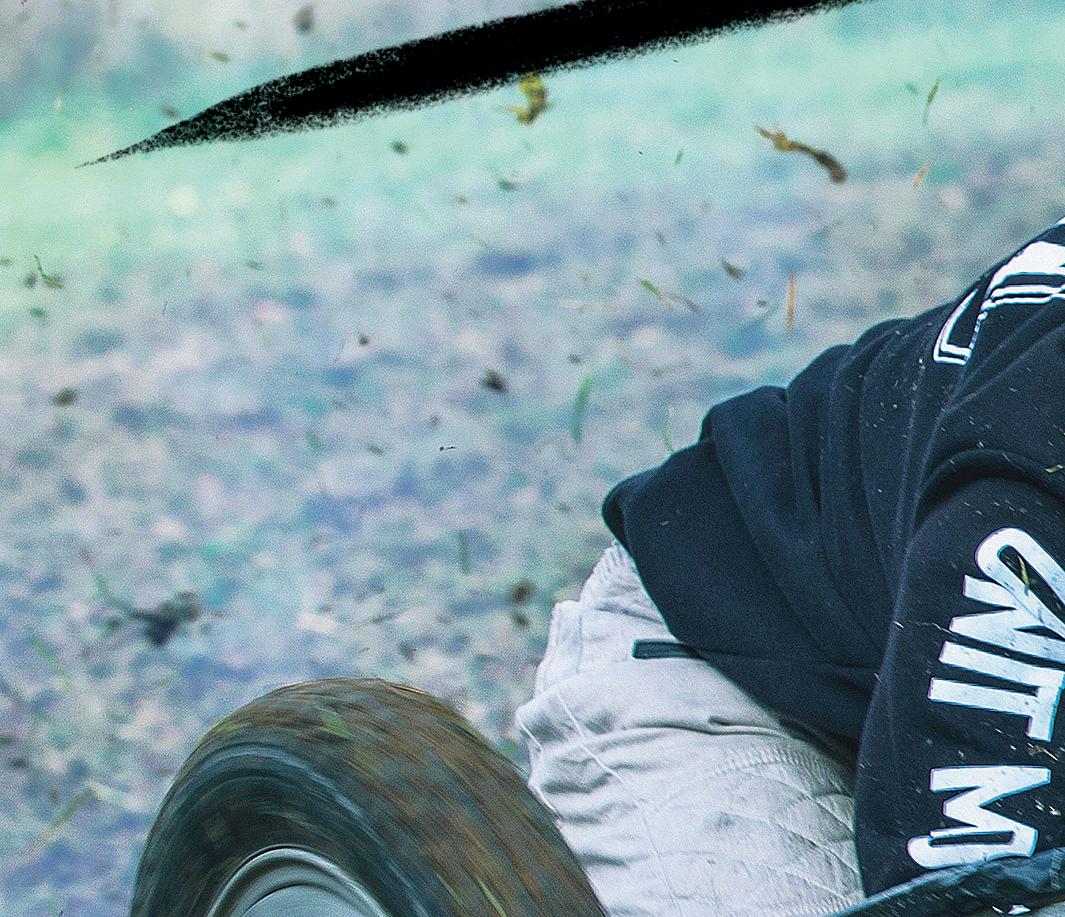

Words: Mick Phillips
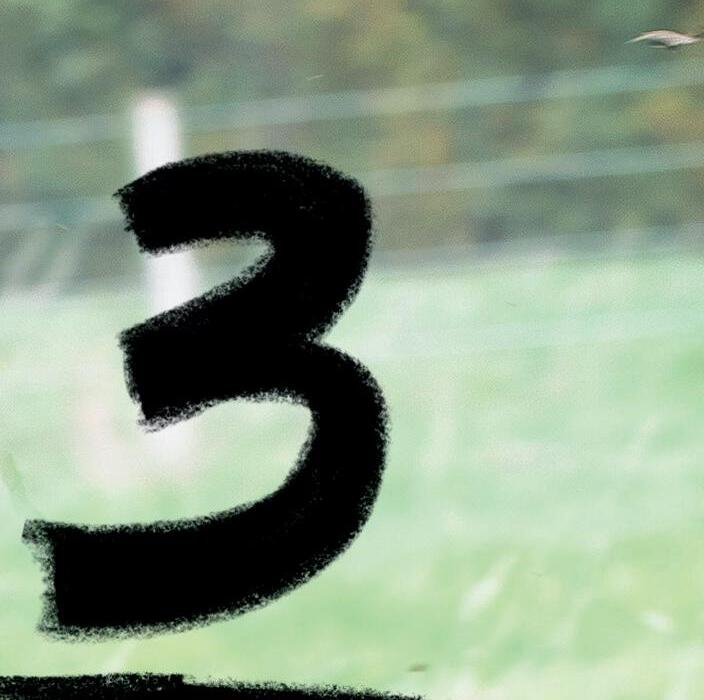





Photos: Denis Boussard


All the inconvenience of a car with none of the advantages.

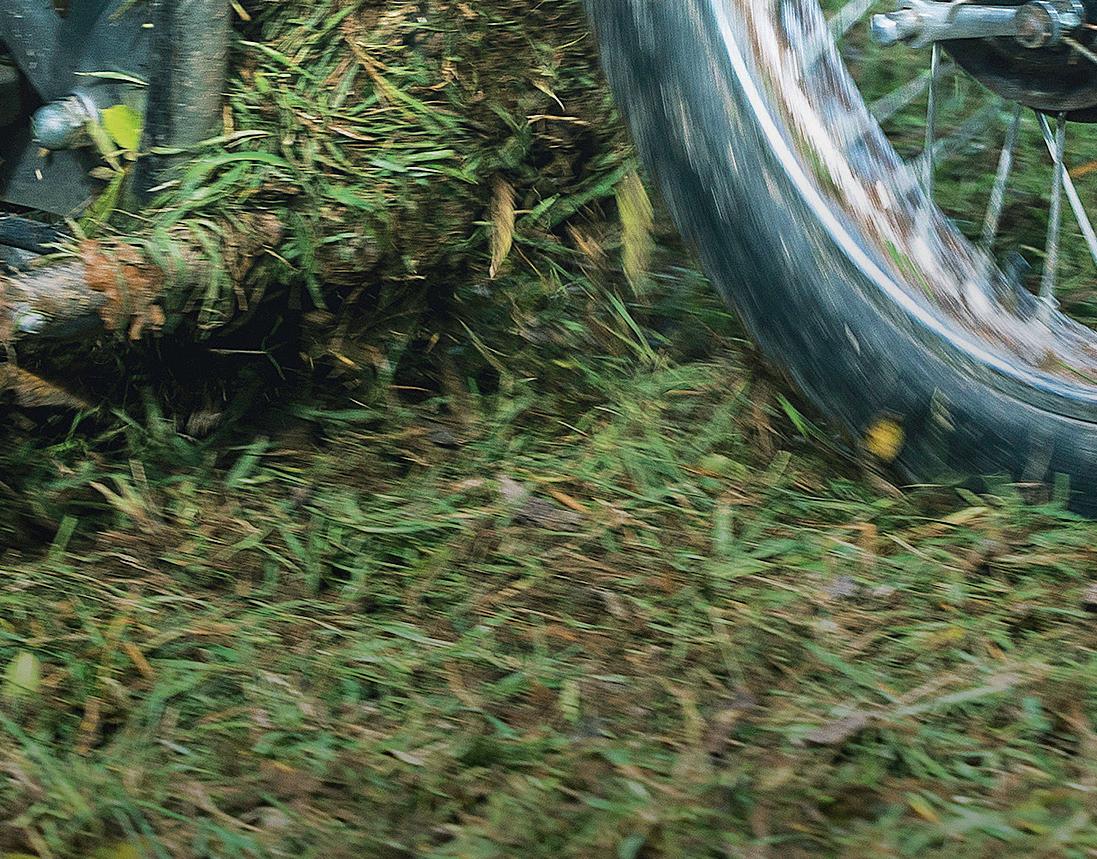
>>
45
We don’t know why we’re fascinated by sidecars, but we are
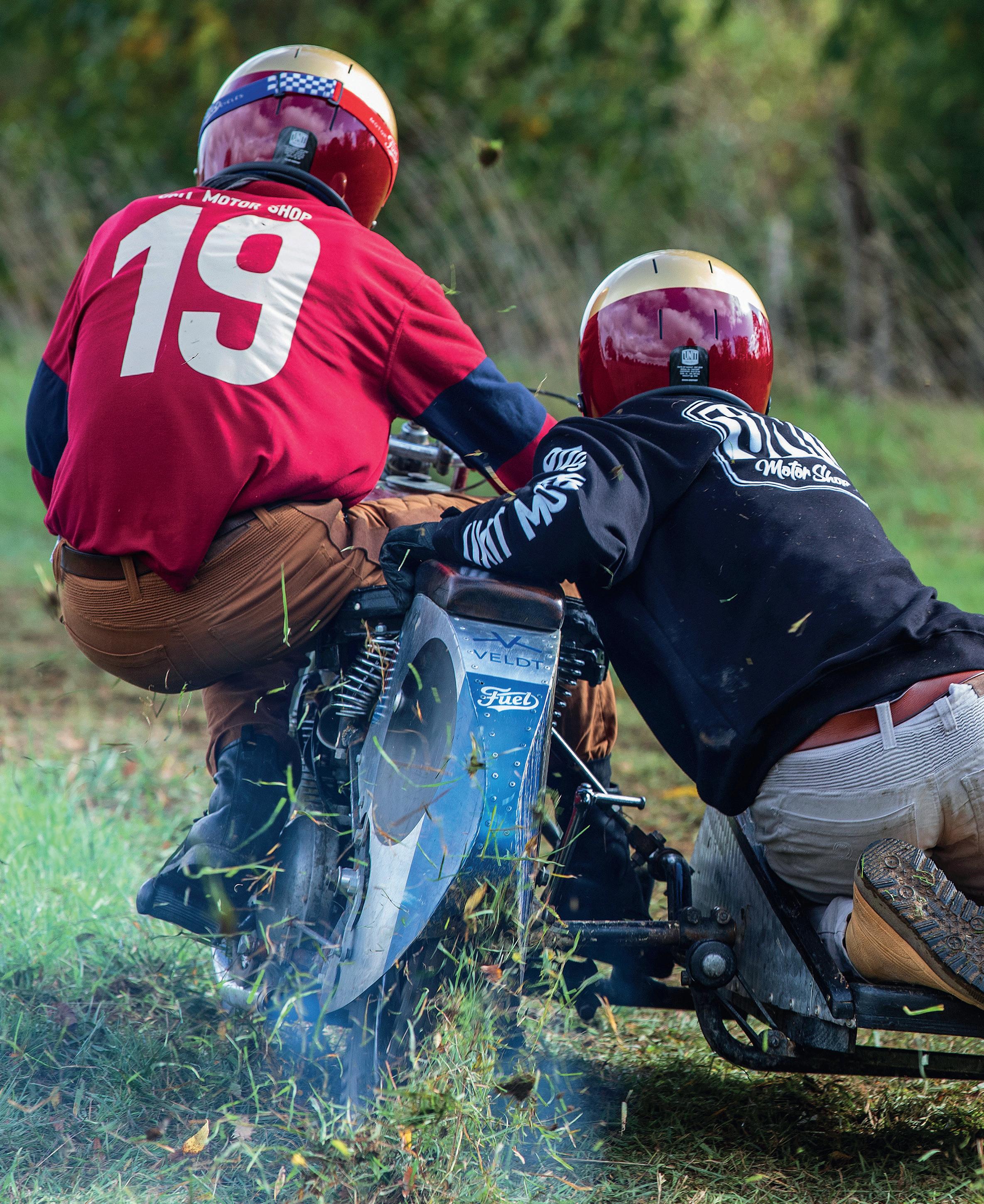
Flashbacks. Disturbing flashbacks. The photos on these pages have triggered memories of chaos, pain, naked fear and hysterical laughter, the latter usually brought on by the relief of coming through a near-death experience relatively unscathed. Memories of my time with sidecars.
Take it to the Press Trial, they said. It’ll be a laugh, they said. The Press Trial was an annual piss-up disguised as a motorcycle trial, contested by members of the bike print media in fancy dress. The contraption I was being urged to compete on was a brutal lump based on a Russian Ural outfit, which, despite its stripped enduro spec, still weighed about the same as a small car. It had a BMW R100 motor fitted, full-on knobblies and a driven chair wheel. I’d never ridden an outfit before, nor ridden in a trial, but I was young, enthusiastic and stupid, so I agreed and badgered a colleague to passenger me.
Comparing riding a solo motorcycle to riding an outfit is a bit like comparing geometry to custard. A couple of old-timers on Motor Cycle News, where I was working at the time, had tried to give me advice. Stuff about weight distribution, accelerating around left-handers and shutting off coming into right-handers; about the chair ‘coming round’ under braking… but as they jabbered I glazed over. Yeah yeah, I’ll work it out, granddad.
On a grey, damp morning we set off on the 150-mile ride to Kent dressed as characters from the kids’ TV show Thunderbirds. Greasy roads, chunky tyres, idiot at the controls of a giant tea trolley. As we rounded the bend I’m not sure who screamed the loudest, Sean in the chair or the old bloke in the Mini, as Scott and Virgil Tracy perched on a ton of metal drifted gracefully and inevitably across the white line and into his path. For an 80-something, he had remarkably good reactions to avoid both us and the ditch.
OK, I thought, lesson learned. But the rest of the ride was still seat-of-thepants at best as I fought instinct with a logic based on zero knowledge of what
I was meant to be doing. Wrestling a greased pig into a wetsuit would have gone smoother.
The trial took place in the hilly woodland surrounding the Brands Hatch race circuit. Until that day, I hadn’t realised how many different facial expressions could register incredulity. ‘You’re not taking that round, are you?’
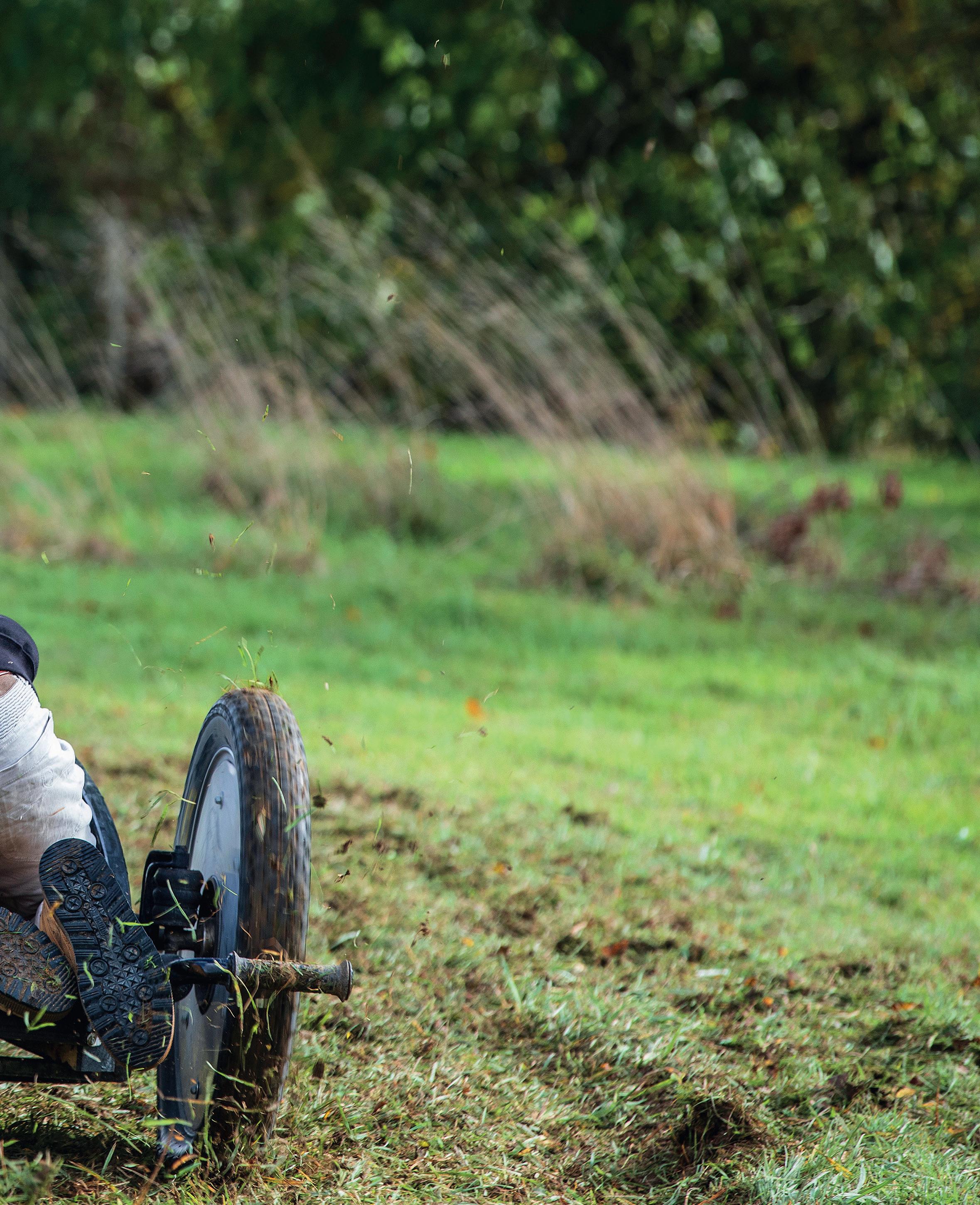
The third section was a steep climb between trees up a slimy bank. No problem for an outfit with a driven sidecar wheel and diff lock. However, the descent was… different. Different in that there was no element of control as we hurtled towards a tree, all wheels locked. We shrugged off the impact as marshals helped us heave the lump out of the undergrowth. By the end of the day my boot was full of blood and I could barely walk. Still, being pissed and having a trophy for Best Crash helped. Sidecars, I could go on…
What we have here, dredging up these bittersweet memories, is France’s very own Gilles Grepinet with his son Simon, ragging the nuts off a grasstrack bitsa based around a 1938 500cc Triumph Speed Twin motor. Built during last spring’s lockdown, Gilles, well-known across Normandy and beyond for his engineering skills with British bikes, used stuff he had to hand. A damaged BSA B31 frame was married to a hardtail from an old chop; Ariel fuel tank; BMW wheels... The motor was treated to a crankshaft and 3134 camshaft, both from a Bonneville, and the head was worked on by Formula 1 mechanic, Master Jacky. Of course, the whole thing was then fatally compromised by bolting on a UMS sidecar, but that didn’t stop the family race team completing last year’s Normandy Beach Race. Chapeau! @unitmotorshop

Samuel Lee Turner
Satanic black metal, half-dead barbarian warlords, moto
bounty hunters, vampire queens… and rabbits. Inside the head of the Denver-based illustrator


Words: Gary Inman
‘Rabbits were partially a joke,’ says Samuel Lee Turner. ‘They were fun to draw in a cartoon sense, but I started putting them in illustrations that were usually the most screwedup in a satanic or black metal vibe. I just had to have a rabbit in the scene somewhere to finish it off. People can look at the image and be like, “WTF is going on here? Oh look! There’s a rabbit! Ha ha!”’
Sam is a full-time bicycle courier in Denver, Colorado, a city situated a mile above sea level. Think about that, and his lung capacity, for a minute. ‘The nice thing about being a freelance artist is I have a regular job that pays the bills and keeps me out and about riding my bike, so when illustration jobs are available, I can choose to do the work or turn it down if it doesn’t appeal to me.’
Like many of his generation (he’s 52) Sam didn’t really consider art as a viable occupation when career choices were there to be made. ‘I was really into fantasy art, toys, horror, comics, like what kid isn’t? I often found myself referring to all of this and coming up with new ideas of my own, but my upbringing gave me many responsibilities as a teen, taking care of a brother and being home
>>
49
a lot. I was more into goofing off, getting into trouble and having fun rather than being serious and looking for an occupation in art. Not going to art school didn’t help, either. I would do illustration here and there growing up, art for the local skate shop back when I was a teen and early 20s, but it wasn’t till I moved to Denver, around 1995, that I started to do illustration more.’
Sam’s varied artwork is often dark and phantasmagorical, inspired by reading the art-based fantasy magazine, Heavy Metal. It led to liking the works of Moebius and Paolo Serpieri1, then Drew Struzan’s movie poster art, Bernie Wrightson, Thomas Holm2 and other comic book and album cover artists. ‘Current inspirations are João Ruas and Pascal Blanché3,’ says Sam. ‘And, not by any means current, but due to their techniques, I’ve been getting into Hajime Sorayama and Olivia De Berardinis.
‘I always loved ink illustration, whether it be really detailed or just simple linework, or cartoons. I mostly work in mixed mediums when doing colour. It can involve pencil, ballpoint pen, Prismacolor coloured pencils, watercolour, gouache, acrylics, airbrush, spray paint, micron ink pen, Japanese ink brush pens. Sometimes all of the above.’


You’re more likely to see a photo of a beautifully restored, classic Italian track racing bicycle on Sam’s Instagram feed than a motorcycle, but motorbikes have intersected his life for years.
‘They first came about when I was a child. My stepmother moved in with us from California, they had dirt bikes,’ Sam explains. When it comes to the first rides, he says, ‘I was a little scared. My brother tried to teach me to ride, but was kind of a prick about it when I couldn’t figure out the gears. We argued and I pretty much didn’t do it. So, I didn’t really grow up with motorcycles. I would hop on one here and there, but I was really into BMX, so I felt I wasn’t entirely missing out.’



APPENDIX

1 2 8 9 7
1. Influential French and Italian comic artists 2. Struzan created poster art for Blade Runner, The Thing, Indiana Jones and hundreds of other blockbusters; Wrightson was a fantasy comic book artist; Holm created heavy and thrash metal LP covers 3. Find them on Instagram at @ feral_kid and @pascalblanche



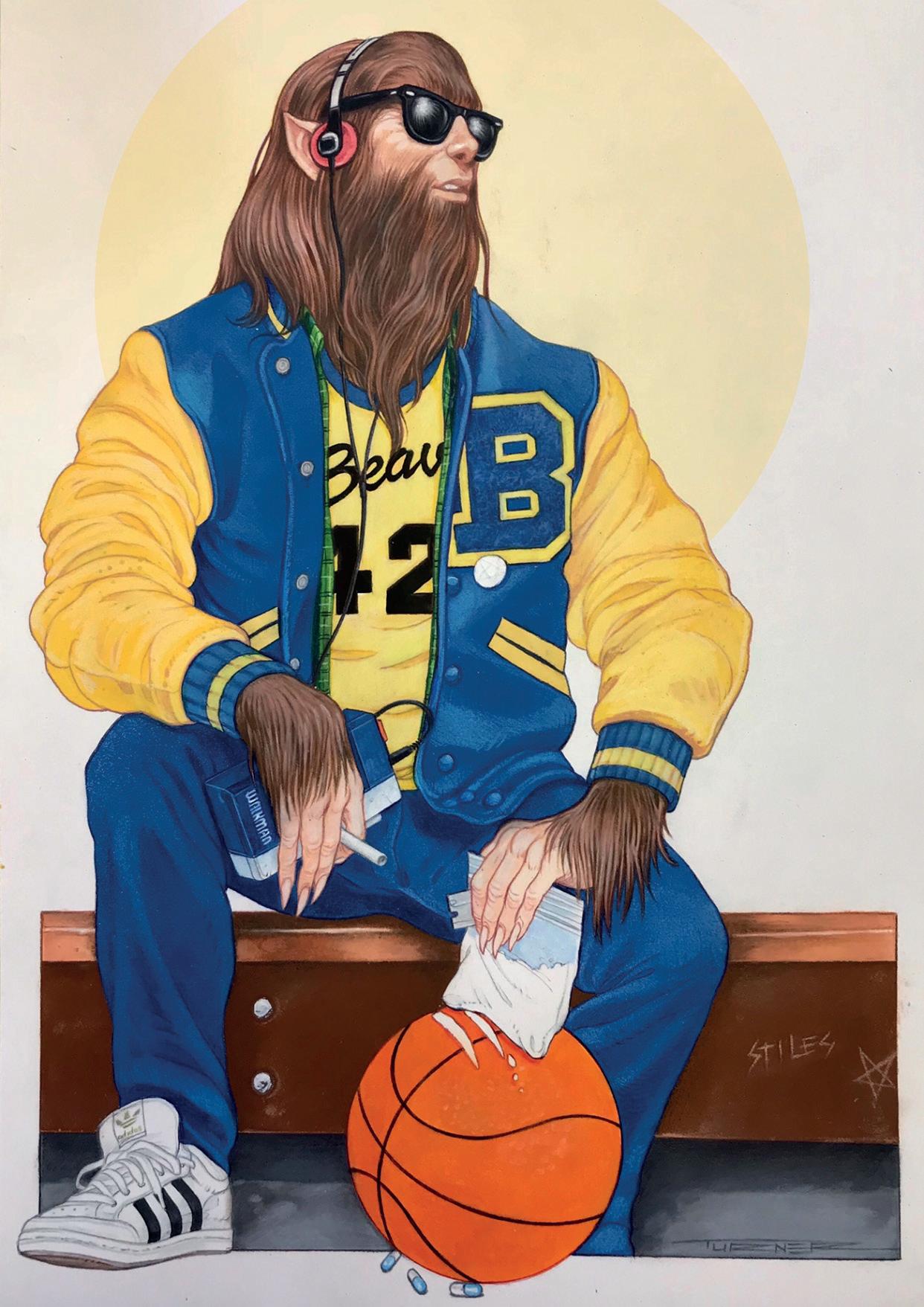

6 5 3 4
‘I would do illustration here and there growing up, art for the local skate shop back when I was a teen and early 20s’ >>
1. Satan artwork for the band Jewel Throne 2. Sweet Severine, a random illustration 3. Speedwolf, up all nite 4. Travis Newbold on the Oishi Yoshio Ronin PPHC race bike, based on a photo I took at the starting line 5. Yakuza hand-painted Ronin art bike 6. Skye Savage, piece from an art showing 7. Streetcleaner ink illustration for a motorcycle art show 8. Turbo Kid, painted on a wood block 9. Reigning Mud T-shirt art for Travis Newbold (previous page) Cover art for Speedwolf music release



1 3 2
1. Val the Russian, another art show piece 2. Another shirt design for a Newbold’s Motorbike Shop event, the Meow Meow Massacre Camping Extravaganza 3. Angel of Death, art show piece
In Denver, Sam made friends with a Harley custom builder, but, he admits, ‘I never really fully got into motorcycle culture, I just have friends who are into it and I’m either there or I’m not. I had a Harley Ironhead I was gonna build up but sold it, because I was working on a 1973 Chevy van and everything was going into it. I own a Sportster, that I pretty much stripped down and started building into a tracker, but the van was the priority.’
Sam had a roommate for a while who coowned a bike shop and they’d go to flat track races, where Sam would race the minibike class ‘because who wouldn’t? But, I think, with motorcycles I’m always that guy on the outside looking in’.
Still, motorcycles kept coming into his life. Like when another of his friends told him about Ronin Motorcycles4

‘The project was amazing. I got involved thanks to a good friend, Dusty Terry, who was part of a crew building these [limited production] bikes in Denver. They were based on stripped-down Buells, totally redesigned as a custom collectors’ bike of which only 47 were to be made, tying in with the story of the 47 Ronin warriors.’
The company, financed by firearms firm Magpul, chose artists to create paint schemes for some of the Ronins, and Sam was one of those chosen. ‘I first saw the bike and thought this goddamned futuristic motorcycle looked like it came out of a future Chris Nolan Batman film.’
The early models were matt black and graphite grey. ‘There was a great amount of surface area to draw on and come up with something cool. I was supposed to just draw one concept, then paint it by hand, but getting to know the whole crew and talking over the ideas meant I was brought in on other concepts.’
In the end, Sam didn’t complete his original idea, but helped create a Yakuza tattoo-themed bike and a series inspired by vintage race bike liveries. ‘Bold colours, stripes, logos and sponsorship brands, all to give a real race bike feel. On a totally amazing bike to boot. It was all a great experience,’ he says.
>>
APPENDIX 4. Purposely short-lived company that always planned to create just 47 motorcycles then close. We road-tested one of the bikes in SB19.
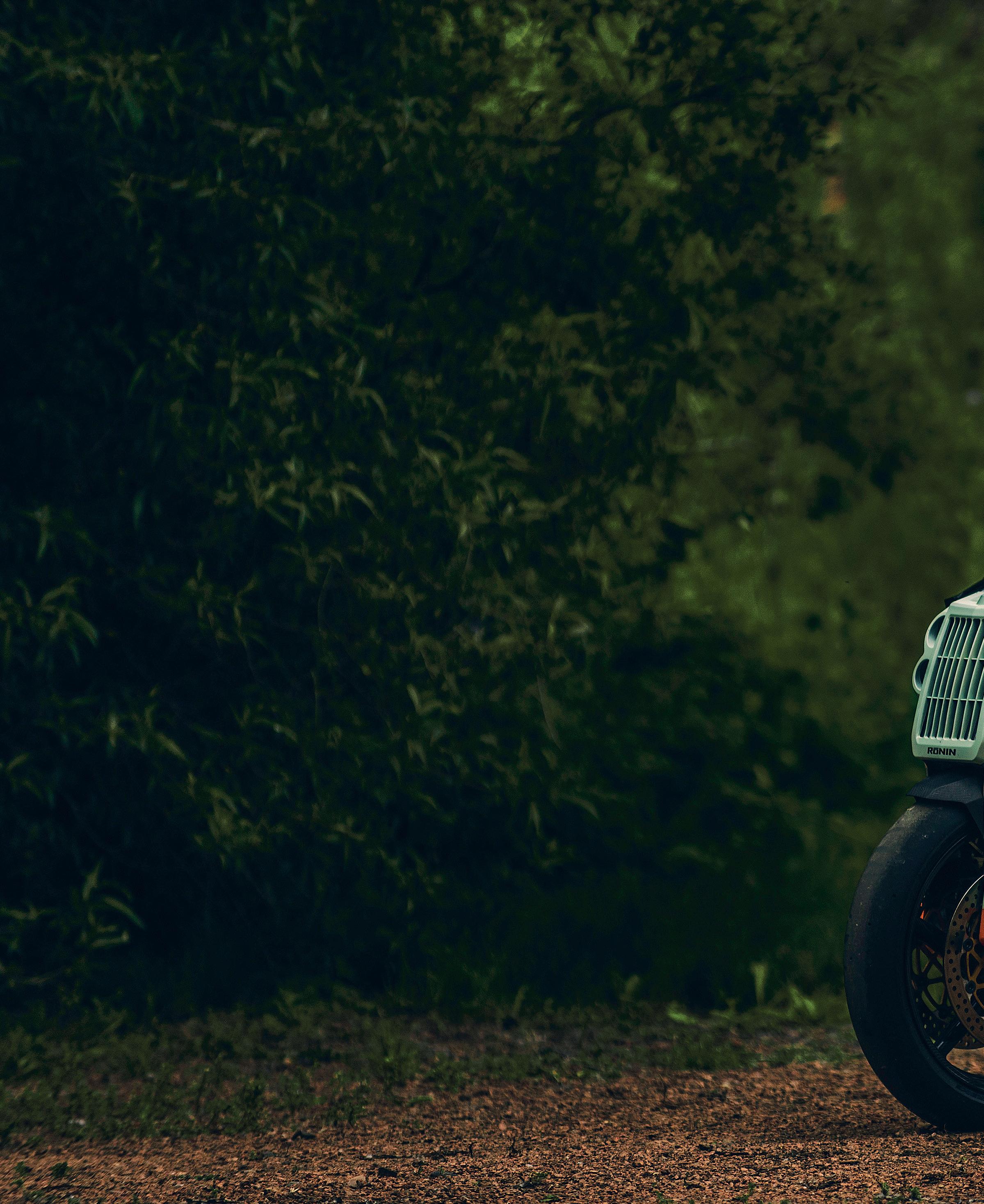 Ronin’s Pikes Peak race bike, Oishi Yoshio. Livery designed by Samuel Lee Turner; raced to class victory and second overall in 2015 by Travis Newbold (behind a Fireblade supported by American Honda)
Photo: Brandon LaJoie
Ronin’s Pikes Peak race bike, Oishi Yoshio. Livery designed by Samuel Lee Turner; raced to class victory and second overall in 2015 by Travis Newbold (behind a Fireblade supported by American Honda)
Photo: Brandon LaJoie

In addition to the seven vintage race bike paint schemes, Sam also designed the Mospeada5-inspired paint scheme for Ronin’s Pikes Peak race bike. ‘That was my introduction to the great Travis Newbold, your magazine’s poet, and an amazing racer that they got on board to race this beast up Pikes Peak6.’
Some of Sam’s most recent art has been for Travis: a satanic Donald Duck T-shirt for Newbold’s Motorbike Shop, and an apocalyptic biker cat for a small event Travis cooked up. Looping back to his early inspiration, now Sam creates LP artworks, but his most regular client is TRVE Brewing, for whom he creates death metal-themed can, bottle label, merchandise and marketing artwork. Yet, because he can take or leave the commissions, not live or die by them, he says, ‘A lot of my work is self-generated and I feel it’s important to keep ideas going and styles and interests, both mediums and/or subject matter, fresh new and fun.



‘Usually, the idea is out of my head,’ he continues, ‘jotting down a rough sketch to paper, then gathering the necessary reference material if needed. Good reference is very helpful. If I had to draw a chainsaw or a wolf I could probably do it out of my head, but if you get reference photos, it just helps to make it that much better, even for goofy cartoony shit. When drawing something, say a portrait of a woman, I tend to use reference photos from friends or acquaintances as a model for their likeness and I make up the rest of the subject matter for the piece.’

In an increasingly dog-eat-dog, ultracompetitive world, Sam’s attitude is refreshing. ‘Art is something I do in my spare time. I have been a bike messenger for 22 years and usually would work on my art in my downtime between deliveries, after work, and weekends. I don’t have a website and I get plenty of clients or fans liking what I do and getting commissions for work or buying art prints and originals. Obviously, I could do even better if I had a store or site, but sometimes I’m stubborn and just do what I do and deal with it.’
APPENDIX
1
 5. 1980s Japanese cartoon TV series that heavily features motorcycle-riding characters. 6. The Coloradobased Ronin Motorcycles enlisted Colorado rider Travis Newbold to race the world-famous Pikes Peak International Hill Climb after Sideburn’s editor suggested him. Travis won his class on the bike. See SB22.
5. 1980s Japanese cartoon TV series that heavily features motorcycle-riding characters. 6. The Coloradobased Ronin Motorcycles enlisted Colorado rider Travis Newbold to race the world-famous Pikes Peak International Hill Climb after Sideburn’s editor suggested him. Travis won his class on the bike. See SB22.
first TRVE brewing illustration. It’s still sold as a shirt to this day 2. Media Blitz unused art for a group show that didn’t happen




deliveries
 1. The
1. The
2
3. Hoop Dreams, a brushpen doodle made between
at work 4. The Soultaker, more brushpen fun at work 5. Apple, from the film Turbo Kid, that I made as a limited run of giclée art prints 6. Maggie/Tiny Daggers for the fun of it
3
4
5 6
A couple of dozen 1960s-era British racing sleds snarled and lurched on the Mojave Desert surface like circus lions waiting to be released from their cages. Giant rubber bands snapped aside and the bikes roared off with copious amounts of white smoke blasting from their exhaust pipes. After a whirlwind of dust, tumbleweed, gas fumes and cheering from bystanders, the racers disappeared over a nearby hill to battle the rugged Southern California desert and each other. Welcome to the Biltwell 100.
The Biltwell crew has a bit of a Midas touch when it comes to events. Any affair they take charge of is always a hoot, where every type of rider and any
kind of motorcycle are welcomed with open arms. That was most definitely the case with this shindig. Men and women competed on bikes running the gamut, from pull-start minibikes and 1970s Huskys to modern ADV bikes and everything in between.
Depending on the racing class, competitors completed one to four laps on a well-marked, 25-mile course with most classes doing three or four laps. If you’re unfamiliar with desert racing, a 25-mile course may not sound too demanding but I’ll be the first to tell you otherwise.

I competed in the one-lap ‘Misfit’ class, open to any type of bike, skill level and rider age. The organic, thrill-ride of
a course had a way of working my limbs into spasms from the seemingly neverending whoop-de-doo sections (and I’ve been doing a lot of trail riding lately). Three or more laps of that is no joke. As arduous as the course was, it was some of the most exhilarating terrain and fun I’ve had on two wheels. That was the consensus from all I talked to over the weekend. Good times indeed.
QUESTIONS KEY:
That’s how Biltwell touted their foray into hosting a motorcycle desert race
1. Name and age 2. Hometown 3. Bike 4. Main modifications 5. What’s the best thing about desert racing? 6. And the worst thing? 7. What will you do, or change, before entering another Biltwell 100?
Words and photos: Ed Subias

>> 59
to expect. I’m ready to do it again



 1. Brian Barbaruolo, 32 2. Los Angeles, CA 3. 1995 Honda XR650L 4. Wiseco pistons; Yoshimura exhaust; ProTaper bars 5. Dodging lizards at 65mph 6. Sand washes with old tyres! 7. Knobbier tyres
1. Jason Rodgers, 36 2. Huntsville, AL 3. 2004 HarleyDavidson Sportster 1200 4. Dual-sport tyres 5. The desert is rad! It was my first time riding in these conditions. Everything was new and fun to experience 6. Sand! 7. Nothing really, other than setting the bike up better for the desert. I kinda jumped into this head first not knowing what
1. Wayne Sutton, 46 2. San Francisco, CA 3. 2019 Triumph Scrambler 1200 XE 4. Low-mount Zard exhaust; Givi engine guards; Luimoto seat cover with custom low seat 5. The connection between you, your motorcycle and the desert elements 6. When race day ends, but that’s when you start planning for the next adventure 7. Race on a smaller bike or an off-road-capable electric motorcycle
1. Eric P Ahlquist, n/a 2. Menlo Park, CA 3. 1970 Husqvarna 400 Cross 4. Engine by John LeFevre 5. The rubber-band start. It felt like I was reliving On Any Sunday 6. Stalling my bike on the line 7. More bike prep
1. Brian Barbaruolo, 32 2. Los Angeles, CA 3. 1995 Honda XR650L 4. Wiseco pistons; Yoshimura exhaust; ProTaper bars 5. Dodging lizards at 65mph 6. Sand washes with old tyres! 7. Knobbier tyres
1. Jason Rodgers, 36 2. Huntsville, AL 3. 2004 HarleyDavidson Sportster 1200 4. Dual-sport tyres 5. The desert is rad! It was my first time riding in these conditions. Everything was new and fun to experience 6. Sand! 7. Nothing really, other than setting the bike up better for the desert. I kinda jumped into this head first not knowing what
1. Wayne Sutton, 46 2. San Francisco, CA 3. 2019 Triumph Scrambler 1200 XE 4. Low-mount Zard exhaust; Givi engine guards; Luimoto seat cover with custom low seat 5. The connection between you, your motorcycle and the desert elements 6. When race day ends, but that’s when you start planning for the next adventure 7. Race on a smaller bike or an off-road-capable electric motorcycle
1. Eric P Ahlquist, n/a 2. Menlo Park, CA 3. 1970 Husqvarna 400 Cross 4. Engine by John LeFevre 5. The rubber-band start. It felt like I was reliving On Any Sunday 6. Stalling my bike on the line 7. More bike prep
 1. Jordan Cathey, 28 2. Murrieta, CA 3. 1977 Yamaha TT500 4. Hot Dog Kustoms paint; Profab swingarm; Works Performance shocks; Mikuni 36mm roundslide carb 5. Camping with friends; going way too fast across the desert 6. Breaking your bike in the middle of the race 7. Train more for endurance and get suspension upgrades
1. Jordan Cathey, 28 2. Murrieta, CA 3. 1977 Yamaha TT500 4. Hot Dog Kustoms paint; Profab swingarm; Works Performance shocks; Mikuni 36mm roundslide carb 5. Camping with friends; going way too fast across the desert 6. Breaking your bike in the middle of the race 7. Train more for endurance and get suspension upgrades
>>
 1. Marissa Silva, 43 2. Orange, CA 3. 1982 Honda XR200 4. ASV levers, because I tend to break levers and those are unbreakable! 5. The feeling of accomplishment crossing the finish line 6. Deep sand is my nemesis! 7. Get a modern bike with better suspension and electric start! But I still love my old Honda
1. Marissa Silva, 43 2. Orange, CA 3. 1982 Honda XR200 4. ASV levers, because I tend to break levers and those are unbreakable! 5. The feeling of accomplishment crossing the finish line 6. Deep sand is my nemesis! 7. Get a modern bike with better suspension and electric start! But I still love my old Honda
wait to do it again next year



 1. Jason Pauls, n/a 2. Huntsville, AL 3. 2003 Harley-Davidson Sportster 1200 4. Suspension 5. Hopefully I’ll be able to tell you more next year 6. Wrecking 45 seconds off the start! 7. Rebuild the bike and get ready for next year
1. Mark Walters, 58 2. Santa Ana, CA 3. 1965 Triumph TR6 in a 1969 Trackmaster Desertmaster frame 4. Betor forks; Works Performance shocks; twin Webco air cleaner 5. Not having to stop 6. Breaking down 7. Nothing except bring a little bit more water
1. Rich Silva, 47 2. Orange, CA 3. 1995 Harley-Davidson Sportster 1200 4. Honda CRF450 front end; 17.5in Race Tech shocks; custom Stealth Pipes exhaust 5. Me racing against myself 6. Crashing 7. Finish the bike build more than one week before the race
1. Jason Pauls, n/a 2. Huntsville, AL 3. 2003 Harley-Davidson Sportster 1200 4. Suspension 5. Hopefully I’ll be able to tell you more next year 6. Wrecking 45 seconds off the start! 7. Rebuild the bike and get ready for next year
1. Mark Walters, 58 2. Santa Ana, CA 3. 1965 Triumph TR6 in a 1969 Trackmaster Desertmaster frame 4. Betor forks; Works Performance shocks; twin Webco air cleaner 5. Not having to stop 6. Breaking down 7. Nothing except bring a little bit more water
1. Rich Silva, 47 2. Orange, CA 3. 1995 Harley-Davidson Sportster 1200 4. Honda CRF450 front end; 17.5in Race Tech shocks; custom Stealth Pipes exhaust 5. Me racing against myself 6. Crashing 7. Finish the bike build more than one week before the race
>>
1. Douglas Yeomans, 35 2. Anaheim, CA 3. 2020 TrailMaster Storm 200 4. Exhaust; intake; bigger jet; torque converter 5. The people and the camaraderie 6. Having no suspension 7. I wouldn’t change a thing. I had a blast running the course on the minibike and can’t
1. Paul LaVigne, 31 2. Anaheim, CA
3. 2014 pull-start with Predator 212 motor

4. Torque converter 5. When other dirt bikes cheered us on as they passed us 6. The minibikes had such a hard time getting through the sand when frame-deep in it
7. I’d definitely try to put some suspension on the bike

ARMOURING THE RISK-TAKERS

Work of Art
The age-old question: Which came first, the bike or cartoon representation? Oh, it was the bike… OK

‘Oi, mate, your headlight’s too small and that front tyre is just stupid.’
Is it? Er, thank you, all-knowledgeable SocialMediaMan. What do I now do with this information? Do I rush into the workshop to make the alterations in readiness for his approval? Probably, but I’ll just check his account first, just to make sure he’s qualified. Oh jeez, I’m not going to say his bike is shit, because I’m not like that, but if I was, I would definitely say it was utterly shit. All comments are null and void, the headlight stays.
I get where he’s coming from though, but what the two-wheeled turd comment-leaver doesn’t know
Words: Jason

Illustration: Adam Nickel
Photo: Allison
>> 67
‘I try to wave back.





is that my bike was styled after one of those bulked up, meat-head doormen. You know the ones, their heads end up looking too small for their chunked-up bodies. They can be seen grappling regular Joes by the neck and flinging them out of their establishment onto the street, when all Joe had done was be a really good customer and buy lots of beer. And dance on a chair. Perhaps.
So, it was while laying in the street that this bike’s style came to full fuzzyheaded vision. A brute in a suit.
Next day beer fug has me contemplating a Norton! They don’t get great reviews. And now they’ve gone out of business [and back into business]. WTF, let’s get one of those then, can’t be as bad a starting point as the Borile1, can it?


Norton fiddlers 72 Motorcycles came to the rescue with one of their street trackers, styled on a Ron Wood big-tube Norton racer of the ’70s. They have modified frames, among a whole heap of other alterations, which I promptly binned. Sorry.
The logo, although true to Ron Wood’s design, made it look like the tank was shouting NORTON, so changes were made: just cosmetic stuff, seat, mudguards, wheels, yokes (now with actual steering lock) and oil cooler. The aforementioned stupid small headlight took place of the number board. Oh, and the exhaust. It’s no longer a street tracker, more of a street scrambler, whatever one of those is.
I’m soon riding my two-wheeled suited brute. It vibrates like nothing I’ve ever experienced before. The vibes are such an intrusive frequency that at tickover my eyes jiggle around like cherries in a fruit machine. I’m at the traffic lights when a lady waves at me. I can’t make out who it is, until I stand up, taking my arse off of the seat, breaking the vibey trail. As my eyes return to normal, I can see that it’s our cleaning lady from work. I try to wave back. Unfortunately, my left arm has been rendered useless by the vibration coming up through the left side of the bars, like one of those cheap palm sanders, all fuzzy buzzy, making for an itchy hand. It’s awful and I decide I can’t take it much more. Luckily, the engine grenades itself on the way home, after just 13 miles. Thank chuff for that. No more vibes.

Someone had set the valve train up incorrectly meaning that the piston had punched the valve right in the face, according to my appointed Norton expert and authorised dealer. Whoops-a-daisy. No bother, just a £3000 repair bill has it sorted. Does anyone want to pay it? The bike’s done 13 miles in its whole life, remember? No? OK, then please allow me.
Back in the saddle and the vibrations are vastly reduced to an acceptable level, but comfort is further improved by making two hulking great brass slugs for the bar ends and rubber mounting the handlebar clamps.
Holy shamoly, my thuggish brute is now smoother than a hot dog. I’m smitten, to the point of rendering the thug in poster form for my garage wall.
And you thought it was for sale. Please contact Jason on 0800-Mr-Fickle.
Unfortunately, my left arm has been rendered useless by the vibration’
Appendix: 1 Jason, who has had more bikes featured in Sideburn than any other individual, described his battle with a wayward Borile B500CR in SB23.

THE 60-YEAR-OLD HAULER FOUND ROTTING IN THE WOODS
 Words: Chastin Brand Photos: Drew Perlmutter
Words: Chastin Brand Photos: Drew Perlmutter
What we have here is a 1959 International Metro. It began its life on Robins Air Force Base, near Warner Robins, Georgia, where it was used to transport the mechanics, tools and parts to the aircraft out on the flight line. After it was decommissioned, it was sold to a local fellow who used it to deliver eggs around our small town of Butler, GA. Eventually, for unknown reasons, it was parked behind the barn where, over the years, the woods came to engulf it and it began to sink into the earth.
Sometime in 2016, my dad and I got talking about doing a trip in something vintage. We decided an old step van would be a cool way to do it, and started scouring the internet for a deal on one. We found a few, but they were either out of our price range or all the way across the country. We remembered hearing about this old step van in the woods

just a few miles from my house, so we went to check it out. After some searching, and a bit of trespassing, we found it. It was better than expected, I mean, it was bad as far as everything about it, but it was way cooler than we expected. It was a Metro, in our opinion the most stylish step van ever made. We tracked down the property owners and eventually talked them into selling it to us for a bit more than scrap value.
During searching, securing and buying the Metro, I discovered the Lemons Rally, an event focused on driving long distances in crappy cars. I figured it would be the perfect road trip for the Metro, plus it would give us a deadline to finish it by. So, with only a month before the start of the rally, we got to work.
Initially, we planned to keep it completely stock, but after seeing that the inline-six >>
71
‘THE INLINE-SIX WAS SEIZED AND KNOWING THE TRANSMISSION ONLY HAD A SLIM CHANCE OF BEING USEABLE WE DECIDED TO GO IN A DIFFERENT DIRECTION’
 The Metro sleeper dozes in the Georgia sunshine. Under that tired body is a 4.8-litre (283cu.in), 285bhp Chevrolet V8
The Metro sleeper dozes in the Georgia sunshine. Under that tired body is a 4.8-litre (283cu.in), 285bhp Chevrolet V8
engine was seized solid and knowing good and well that the original automatic transmission had a slim chance of being useable, we decided to go in a different direction and make it as reliable as possible for as little money as possible.

We found a 2006 Chevrolet Tahoe that had been rolled and totalled, and bought it for $1500. After some measuring we learned the wheelbases were very close, so we decided that putting the Metro body on the Tahoe chassis and running gear would be the way to go. For the next month, afterhours in my dad’s body shop, that’s what we did.
Underneath, we used as much Tahoe as we could, to retain the reliability and driveability, but kept all the cosmetics looking like a crusty 60-year-old van that had just been dragged out of the woods.

For the most part, it went smoothly, but there were a few things that took some creative engineering to overcome. I’m not particularly skilled or knowledgeable when it comes to building four-wheelers. Luckily, my dad is super handy with that stuff and a very good problem solver. I tend to overthink things and get stuck, while he’s able to just go for it without, it seems, much thought. He definitely kept the project moving when I started to stall.

One of the more challenging, unexpected aspects of the build was the wheels. The Tahoe running gear requires largediameter wheels to clear the brakes. We chose aftermarket ‘Artillery’ style wheels. The problem was they only came in one backspacing option, which was too wide, meaning the wheels stuck way out from
the body and looked awful. Though it was something we had never done, we decided to cut the centres of the wheels off the rim, so we could set the backspacing wherever we wanted. The wheels were taken to a friend’s machine shop where we could do it precisely. Everything was set up and clamped down on a completely flat surface and after a full day of using specialist tools and measuring devices, cutting and carefully welding everything back together, the wheels were sent to have tyres fitted. Unfortunately, not one of the wheels would balance. They were completely out of whack. After some thinking, we decided to try a much less precise approach. We mounted the wheels on the van and cut most of the welds loose. A dial indicator was set up on a block of wood and we would spin the wheel find the spot out of true and beat on it with a sledgehammer and another bit of wood to keep from marring the surface. After a bit of spinning, beating, welding, spinning, beating, welding, we had the wheels all trued up. Now everything balanced out and rode great.
The departure date was coming up quick and we still hadn’t driven it, and we knew we had 950 miles to cover to even get to the start of the rally in Moscow, Pennsylvania. The day before we were set to leave, with everything finally buttoned-up, we went for a last-minute test drive. Everything seemed to be running fine until the van was at highway speeds, when it became very unstable, rocking back and forth violently. We thought the front suspension torsion bars were not heavy duty enough, but we didn’t have time to order new ones, so we
If you go down to the woods today... When found, the International Metro had straw, iron oxide and chicket shit full optionals. Later, while Chastin was deep in procrastination, his dad popped the body onto a Chevy Tahoe rolling chassis

>>
 Meticulously restored interior took five coats of Acme Patina applied with the dog’s tail
Near-standard 1974 Honda Elsinore is a regular travel partner
Meticulously restored interior took five coats of Acme Patina applied with the dog’s tail
Near-standard 1974 Honda Elsinore is a regular travel partner
had my wife, Lauren, bring her daily driver Chevrolet Suburban over and we robbed the heavier torsion bars out of it and fitted them to the Metro. That greatly improved the swaying problem (the Suburban got new torsion bars when we returned from the rally).
We finished it up just in time for the trip, which would be 3500 miles including the rally, leaving in the mild winter weather of Georgia in late January to head north. We drove through a blizzard in upstate New York and conquered the Tail of the Dragon road through the Appalachian mountains. The Metro performed as flawlessly as a ten-year-old Chevy Tahoe would.
The bike mounted on the back is my ’74 Honda Elsinore, and is basically all Elsinore except the wheels.
It was built by my friend Butch at Butch’s Vintage Cycle Shop in Perry, GA. It was a collaboration between the two of us, him being the vintage two-stroke expert, who did all of the actual work. I, being whatever I am, would ride and crash it as a traditional form of R&D. The forks are raised through the trees and Butch worked his magic on the engine. It runs really well and has been quite reliable. I feel it’s something you might have seen running at amateur races throughout the ’70s. It’s been a really fun bike to practise on here at my personal track and I can’t wait to get back to some racing soon.
Since that first trip, we’ve continued to use the Metro almost daily, running errands, hauling motorcycles, going on trips and camping at swap meets. It’s basically a Sprinter van, but with a soul. Out of the many vehicles that my dad and I own this has turned out to be one of our favourites and will be something I will eventually pass down to my daughter.








MUTTMOTORCYCLES.COM
Metal From
Black
Birmingham
Chin on the tªnk, 900cc V-twin pinned across the desert, Paul Hartman looked at the speedo and admits...
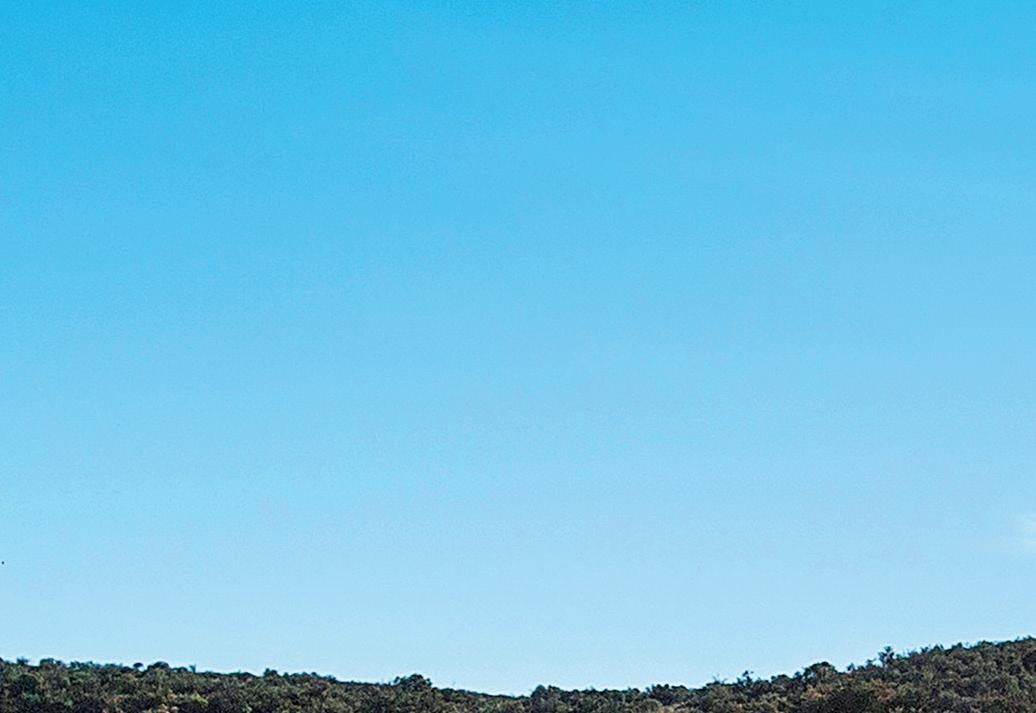


TheDucati Scrambler has won plenty of fans since it was launched in 2015. I’ve always had a soft spot for so-called entry-level Ducatis, from the rectangularheadlight 750SS, to the first-gen Monsters, and now the Scramblers. I struggled to afford the non-entrylevel models, and I’m attracted by the steel-framed simplicity and purity, plus the adequate power and practicality when compared to their increasingly demented superbikes. But there was always something iffy about the self-proclaimed ‘Land of Joy’ PR that accompanied the Scramblers. The whole thing stank of the kind of city gentrification that pushes out the artists, the original settlers, the ones who made an area interesting, to enable the wealthier followers, those who want to simply consume the lifestyle off-the-shelf, to roll in. The Scrambler sub-brand was trying too hard to be cool and quirky and it was rarely hitting the right notes, for me at least, yet there was enough real substance underneath for the new breed of Italian twins to be a success, without out all the hokey marketing.
‘I’ve always really liked the Ducati Desert Sled,’ says Paul Hartman, describing the iteration of Scrambler introduced in 2017, the higher-spec, more trailorientated Desert Sled (I winched as I typed that name). Paul continues, ‘I actually bought one new when they first came out, but sold it after about a year to fund another build. Then, last year, I saw the [US-market exclusive] Desert Sled special edition that Fasthouse1





>>

Words: Gary Inman Photos: Ed Subias
it made me






pucker
i t}
{ªb
77
and Ducati built together. It was a gamechanger for that bike. They really made it work well. Hooligan off-road racing looked like a lot of fun, and my good friend Tony Parent and I had been talking about building bikes, so down the rabbit hole I went.’

Hooligan off-road racing? Yeah. It’s not as contrived as it might sound. In fact, it’s remarkably close to the roots of desert racing. Still a tiny scene, its genesis was when heavyweight road bikes were invited to enter the Mint 4002 in 2019. Former cover star Mark Atkins, AKA the Rusty Butcher, and some of his friends entered on Harley Sportsters and stoked the fire, then Ducati USA sniffed an opportunity to make some marketing hay. They signed up Jordan Graham3 and Ricky Diaz, fitted a couple of Scramblers with serious off-road suspension and won the class. Yes, the class was tiny, but the Ducatis were still scudding across the Nevada landscape at an impressive velocity. The Mint 400 bikes led to the Fasthouse-edition Scrambler that got Paul back onto a Ducati.

‘I did some research on the Fasthouse bikes and talked to Jordan Graham, getting some good insight from him. I also made friends with a couple Ducati techs and learned a lot. My bike is a 2018 Ducati Scrambler Desert Sled. I found it here in Carlsbad, CA. It had a blown rear shock and a few other issues, so I got it cheap. I was going to replace about half the bike anyway, so it was perfect,’ says Paul.
‘I got the bike home and had it stripped down to a bare frame and engine by dinnertime. That part goes
>>
'I got the bike home and had it stripped down to a bare frame and engine by dinnertime. That part goes quick'
Twin-cylinder desert racing baddassery. How much would you pay to watch a class of these take on the Dakar?







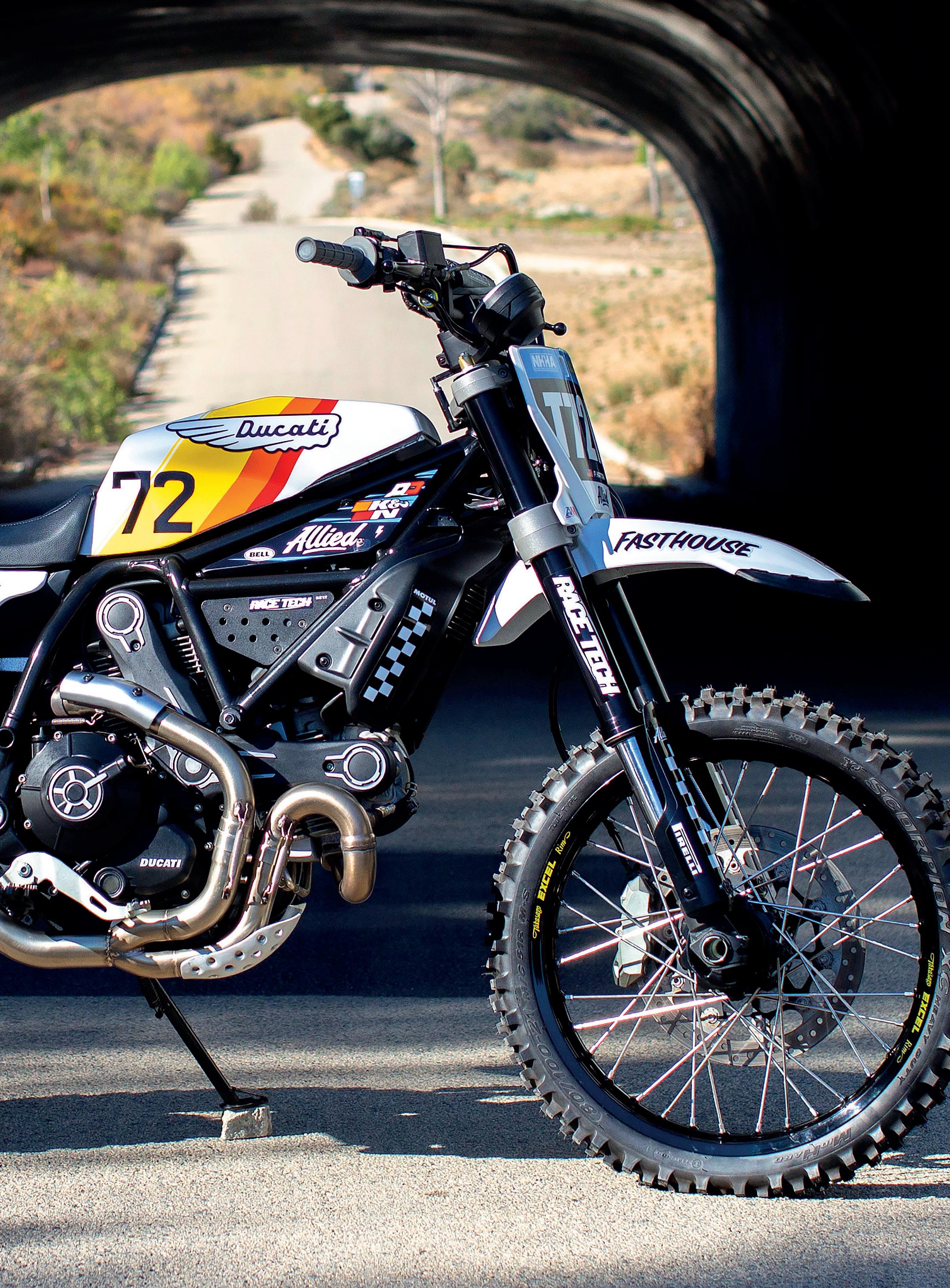






The core is all Italian, the elements that allow the Desert Sled to live up to its (da ) name are the uprated suspension and race-quality rims
quick. From there I could look at it like a blank canvas and start visualising what I wanted it to look like, figuring out what was available to purchase, and what I would have to make custom.
‘For me, the big visual changes come from the tank and seat, so that was important to get right,’ he says. ‘I talked to Walid from Bad Winners in France, who helped me out with a custom tank. The seat came from a custom shop in Italy. It actually didn’t fit with the tank, so I had to get creative with that.
‘The next big items were wheels and suspension. I cut the old wheels apart and sent the hubs up to Dubya to be laced to some Excel rims. The suspension went over to Race Tech. They made all-new custom internals for the forks and rebuilt the stock rear shock. That shock blew out and they ended up making me a completely custom G3-S shock that is truly amazing.’
With all the big stuff out of the way, Paul made a shopping list with a hundred more little things. ‘I could fill up a couple pages with my list, so I’ll stick to the more important items: Flexx bars from Fasst Company are a must. They take out a lot of vibration and soften the blows. Q3 makes a racing low pipe that deletes the catalytic convertor. The stock battery weighs 11lb (5kg), Antigravity makes a replacement that is under 1lb (450g). Then there were lots of little things replaced or removed,’ Paul adds.
Sounds easy, right? ‘Honestly, just being a modern Ducati was the hardest part of the build. It’s so different to anything else I’ve worked on. The electronics, ABS, computers, etc. It’s kind of a pain in the ass. I really wanted to get rid of the giant speedometer, but you can’t. The bike has an immobiliser system and nobody has made an ECU program to bypass it yet. Also, there are no off-the-shelf suspension parts that actually work well off-road. So you need to find someone to build custom suspension for it, like I did with Race Tech.’
Paul builds some fantastic bikes, including the Triumph Bonneville hooligan we featured in SB38, and he rides them till their pips squeak.
‘It’s an absolute blast to ride. It hauls ass and is super stable. The only good part of still having the speedo is knowing how far I’ve gone and how fast I’m going. I looked down going across a dry lakebed and saw 101mph. I was full tuck like I was on the Springfield Mile or something. It felt amazing, like I was fully floating across the sand, but knowing I was on knobby tyres with mousse tubes4 made me pucker a bit.




‘At times I feel like I’m riding a dirt bike, but when you have to lift the front wheel or hop around, you get a quick reminder that you are indeed on a heavy street bike. It’s not the best at slow technical riding in rocks or tight spaces, but when you’re on the gas, bouncing through the desert, it feels amazing. I built the bike to race the AMA national off-road series. They host a

>>
‘It’s an absolute blast to ride. It hauls ass and is super stable'
Small capacity tank was imported from France.
The logo Paul chose dates from 1968
Hooligan class now. The plan is to race the Mint 400, a few select Hare & Hound races, and I entered the Biltwell 100 race [see p58].
Paul’s research paid off and he confirms, ‘So far everything is working really well. Like I said, I’m running mousse tubes instead of standard inner tubes. They work well in the soft dirt, but on the hardpack they feel like flat tyres. They are meant for bikes about half the weight, so it’s kinda sketchy.’
When asked what he’d do differently he says, ‘For racing it’s no big deal, but for distance riding I would go for a larger fuel


tank. It’s only two gallons (7.5 litres), and when you’re riding off-road and burning gas in the sand the range is about 60 miles. On the plus side, it makes the bike lighter.’
When it comes to weight, Paul says the stock bike weighs 461lb (209kg), but his is down to 390lb (177kg) and he’s still looking for more weight to loose. ‘In the end, it’s still a 400-pound bike that’s not meant for off-road riding. But I guess in a way, that’s part of the fun.’
The bike isn’t a one-trick pony, either, ‘I just take the front number plate off and put the headlight back on and I’m cruising the streets.’
APPENDIX: 1. Californian moto apparel firm. 2. Nevada desert race named after the now defunct Mint Casino, which closed in 1988, but was made famous by Hunter S Thompson’s book, Fear and Loathing in Las Vegas. 3. Formerly a Roland Sands Design Indian hooligan ‘factory’ rider and all-round accomplished off-road racer. 4. Launched by Michelin in the mid-1980s, aimed at rally raid, enduro and motocross bikes, a ring of honeycomb foam replaces the traditional pneumatic inner tube and prevents punctures or pinch flats.
 The Ducati is so heavy its shadow weighs the same a 250cc two-stroke
The Ducati is so heavy its shadow weighs the same a 250cc two-stroke
45.476982, 8.583481 Via Case sparse, 8 - Agonate (NO) ITALY ditraversoschool.it
The middle of the night can be a waking nightmare for Erik Hartley. The former US Air Force Crew Chief and Afghanistan veteran explains how flat track racing helps him deal with severe post-traumatic stress disorder
Words: Erik Hartley Photos: Kathy Lynn Photography
’ve stared down the barrel, taken pills, and even stood on a mountain ledge ready to jump. Honestly, if it weren’t for a random family who were camping there, that mountain would have got me.
Discovering flat track saved my life, and that is probably difficult for my wife and family to learn. The notion of flat track racing helping with post-traumatic stress disorder

might be a hard one for some people to grasp, but it helps in two ways: mental and communal. While I’m on the bike, I’m unable to relive anything, the stressors are silenced and I’m forced into the present. When the lid shuts and the RPMs build, I’m catapulted through time and no longer in Afghanistan. My war is over, momentarily. In terms of communal benefits, the pits at a flat track race
are unique and organically poised to help someone who is silently suffering. You’re all together, doing something dangerous and honestly exciting. We all want each other to go home safe and have a hell of a story for when we’re older.
I was a United States Air Force Crew Chief, deployed to Afghanistan in 2010 for 120 days. I was in the Illinois Air National Guard at the time. I spent
the first four years of my service on full-time active duty, then went parttime as a guardsman and attended university full-time. I deployed right after switching. It meant when I returned on a Saturday I was back at uni on Monday. So, much of what could have been easily noticed about my condition was masked by everything, good and bad, associated with being a college student.
But the ability to subconsciously run away disappeared once my wife and I started our family. My PTSD started to come to light when my son began to mimic my behaviour. He was only playing and didn’t understand, but it signalled that I did – do – have a problem. I’d spent so many years distancing myself from that time in my life, blocking everything off, that to ‘go back’ was pretty heavy.
I’d describe post-traumatic stress as feeling as if I’m alone in a crowded room, and half a world away. It didn’t matter if I was holding my newborn child or saying ‘I do’, I was desperately trying to process my experiences and finish my war. I escaped fate, but the black cloud hung. Why did I get to come home? This isn’t the version of myself my family remembers. You want to let go, forget everything, but

>>
85
you can’t. The back side of the clock is the worst, but with the help of flat track, therapy and understanding that I’m not alone, my journey home has become easier. I don’t need to run to find peace. I’m from Springfield, Illinois. Peace has been waiting under my nose all along.
The formation of Evil Hours Racing has been a calling that I can’t easily articulate, but I struggled for so long and one night in May 2019, overlooking the American Flat Track series pits, brought me home. I felt at home for first time since I’d deployed, and my subsequent journey with flat track has proven time and again that PTSD can be overcome. I wanted to build something that I wish I could have had access to when I needed it most. It’s probably not a shock to hear that toxic masculinity is problematic in the military… so is shame. It didn’t feel acceptable to say, ‘Hey I think something’s wrong. I can’t sleep, my mind is racing, I hate everyone that didn’t sign up, and I’m pissing my family off.’ So, I finally figured, let’s help veterans break down stigmas.



It’s OK to be affected by war. War is chaotic, so processing it isn’t easy.
The ultimate goal for Evil Hours Racing is to develop into a leader for helping veterans who are suffering. We want to send as many as we can to slide schools, down into the pits at AFT races, and have them race. We already have agreements with a number of racing schools, partnerships with the factory Honda and Turner Racing teams, we’re the official nonprofit on the Grand National Hooligan Championship, as well as having a really cool deal with race promoters Xtreem Flat Track to allow any veteran we help to race for free.
The feedback has been incredible. As the face of the organisation, I can sometimes feel very exposed and vulnerable, but I know it’s in the service of saving lives. Having people express their gratitude and attach themselves to the nonprofit and its branding makes me emotional to even write about it.
Generally, if there were ever a criticism aimed at Evil Hours Racing, it would be from a position of not understanding the work we
do. We’ve received the Gold Star of Transparency from nonprofit watchdog GuideStar, and my own racing is my own personal investment. It serves as a marketing tool to get our name out. All the money we make, 100%, goes back into the work we do to help veterans. I have a full-time job, so does our entire board of directors.
Additionally, racing is our story. Flat track is saving a veteran that has PTSD. We attend rallies, bike nights and other events, but at a race people are seeing the story unfold, in real life. My best on-track moment doesn’t even involve me as a rider. This past December, Evil Hours Racing attended the Panhandle Clash in Florida, and we supported David Brown, racing for the first time after Evil Hours had sent him to the Texas Tornado Boot Camp riding school. He was scooting, too. Seeing him working lines and picking off riders on the Mad Dog Kawasaki KLX140, and to then come off the track with a massive grin, solidified what we’re trying to do. His smile and spark is not something currently on offer at VA veterans’ hospitals or on a therapist’s couch. >>
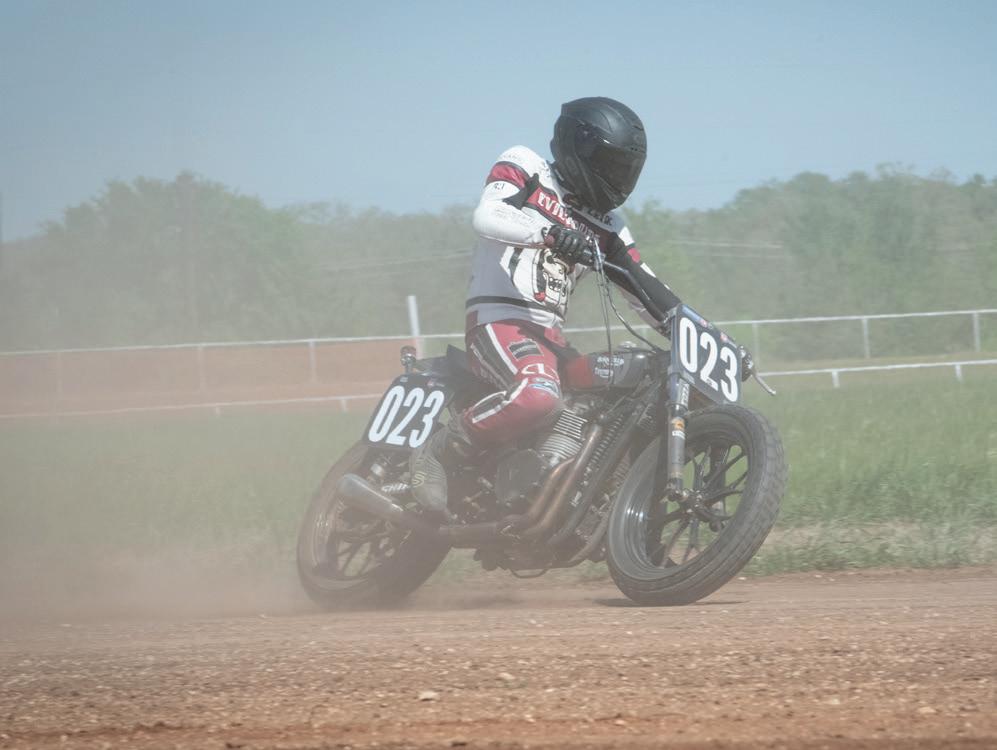


EVIL HOURS HOOLIGAN
When it comes to my racing, I got into the hooligan class because my wife said so. I started off racing the Mad Dog (modified minibike) class, and wanted to jump to a 450, but my wife said, ‘Ugh, you already have a bike in the garage. So figure it out!’
My racer started life as a fuel-injected 2013 Triumph Thruxton 865. My inspiration during the build was always Paul Hartman’s blue bike [Paul’s new desert racer is featured on p76]. I remember googling ‘Triumph hooligan’ and Sideburn 38 popped up. I bugged Paul constantly about it, and, luckily, he was so nice and gave me a roadmap. I worked with Kevin and Shawn at Knight Brothers’ Motorcycle Shop in South Carolina, where I was living, and we went to town. Without their guidance, I would have been lost. In fact, if it weren’t for the entire South East flat track series this bike would still be sitting in my garage as a daily rider.

Bill Gately, of Bonneville Performance, was recommended to me. Bill is a former Marine and Vietnam veteran and has struggled with PTSD. He has worked with other nonprofits but was excited to hear about the work we do and specially working with combat veterans. He built and donated the engine, as a way to say thank you for the work we’re doing.
HOOLIGAN SPEC
Engine: Bonneville Performance (BP)
Nikasil-plated billet cylinders; BP/Wiseco 995cc 10.5:1 pistons; Carrillo rods; 270˚ dynamically balanced crank; ported head; BP cams; 1mm over intake valves; BP/ Ferrea custom valves, spring kit, retainers and keepers; BP cams; BP billet intake manifolds; Mikuni HSR45 carbs; Barnett multi-plate clutch with Barnett Green springs; counterbalance system removed; Tec stainless two-into-one exhaust; 105bhp at the rear wheel; 118nM (87lb.ft) of torque at 4700rpm
Wheels, brakes & suspension: Performance Machine 19in wheels with Durelle Racing hubs; Brembo brakes with Nick Henderson hanger; Triumph Thruxton forks with Progressive springs; Worx shocks; Jeremy DeRuyter adjustable triple trees
The rest: Goon Glass Trackmaster tank and single-sided number plate seat; Mika Metals FTW bars; ODI grips; R-Nyne decals


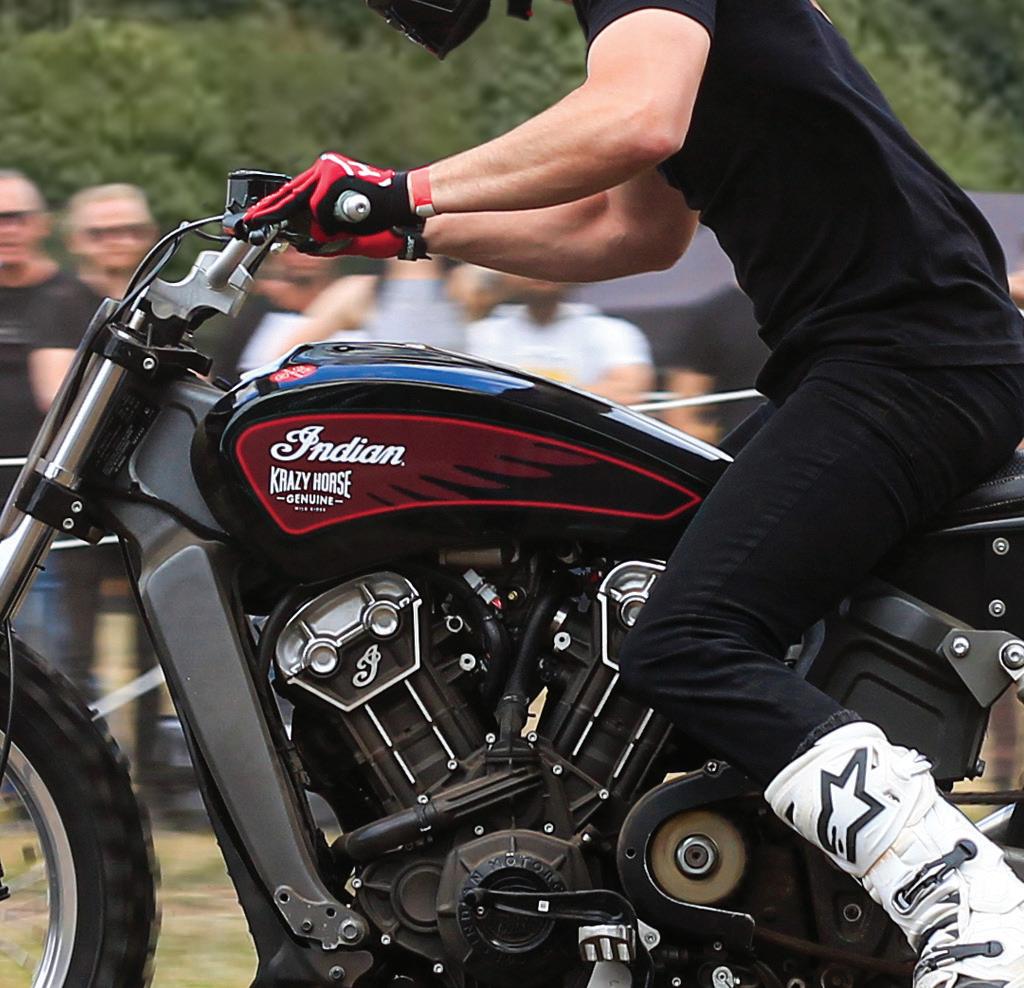








































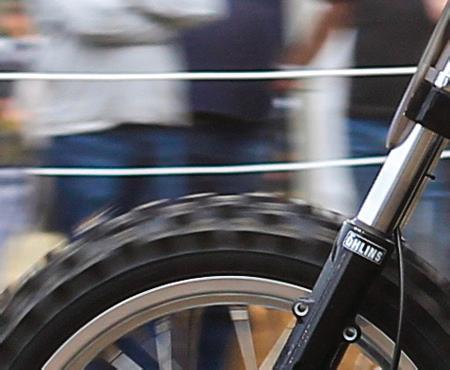













TAMMY









This old photo of Tammy Sessions monstering a Triumph 750 around Castle Rock spiked our interest, but the story of what came before and after is even better


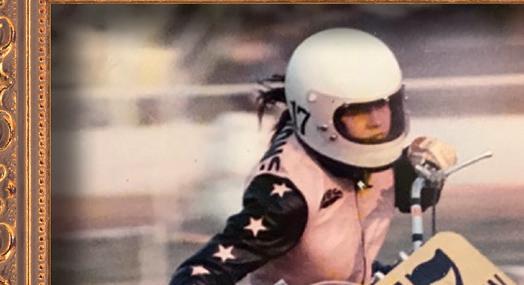
Words: Leah Tokelove Photos: Tammy Sessions archive

In our modern world people are fickle, and it’s becoming increasingly difficult to find anyone that devotes themself to anything. We change, that’s inevitable, but one thing I have come to learn is that motorcyclists are different. Very few of us will devote a lifetime to something, unless that something is motorcycles.

Perhaps you think, Yeah, that’s me. Yeah, I ride. But do you actually ride ride? I thought I rode motorcycles until I got off a two-hour Zoom call with a 66-year-old woman whose garage line-up consists of a brand new Husky 350





>> 91
enduro bike, Honda CRF150, a tidy Harley Softail and a Polaris RZR side-by-side. The person in question was Tammy Sessions, one of the first women to hold an AMA Pro Flat Track racing licence, the Queen of Desert Racing (unlike me, I just refer to myself as a Queen), and a genuine all-round badass.
Hailing from the suburbs of Seattle, Tammy’s’ father bought her a small bike when she was ten, and she spent the next couple of years riding around her neighbourhood sharing her wheels with the other kids. That was the extent of her riding until two years later, in 1968, when her dad caught Washington’s biggest cross-country race on TV and posed 12-year-old Tammy a question. ‘Do you wanna do that?’ She just smiled...

Race day arrived and Tammy remembers, ‘I was sat on the startline and realised I didn’t know what would happen next. I asked my dad, “What do I do?” He told me, “Just follow the person in front!”’ And that was the beginning of a life-long love affair with motorcycles and racing.
Cross-country racing was just the start and Tammy’s weekends soon began to follow a routine. Friday night: indoor flat track; Saturday: scrambling/practice; Sunday: motocross. Basically, riding every discipline available to her on a growing fleet of motorcycles that would come to include some vintage classics. Cross-country was Tammy’s thing, but she had a clear affinity with short track, making perfect sense given that she lives in the Pacific North West, a
hotspot for flat track talent at the time, and also home to an abundance of mullets, both of which she was blessed with during her flat track career.




As a teen, Tammy opted for a motorcycle licence over a car licence, and to celebrate her 16th birthday the Sessions family planned the motorcycle adventure of a lifetime. She recalls, ‘To celebrate, we decided to go on one big trip. My dad, my 19-year-old sister, Cindy, and I rode from Washington state, down through Oregon and California to Mexico. My 10-year-old sister, Jody, wanted to ride pillion, but Mom said, “No way!”, so they flew and met us every couple of days. Dad was on a 500 Suzuki, Cindy and I rode 350 Suzukis.’


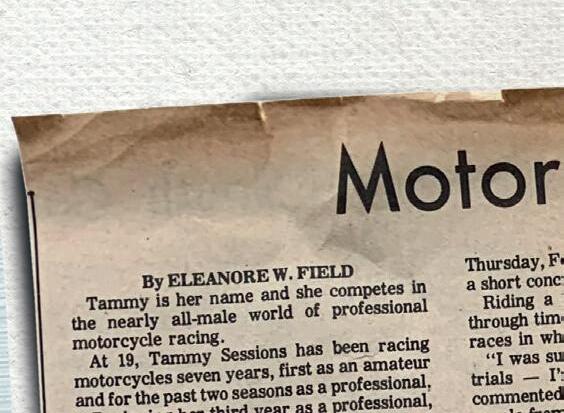

The ride took a whole month and Tammy remembers riding down the

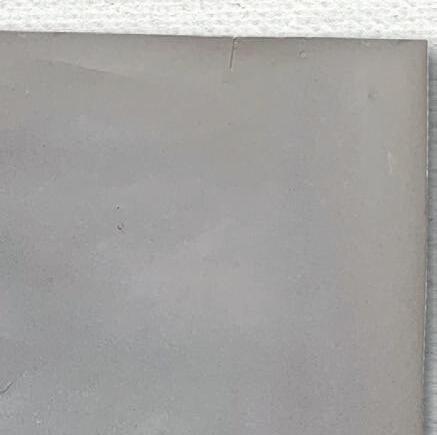



I ASKED MY DAD “WHAT DO I DO?”.
“JUST FOLLOW THE PERSON IN FRONT!” HE TOLD ME,











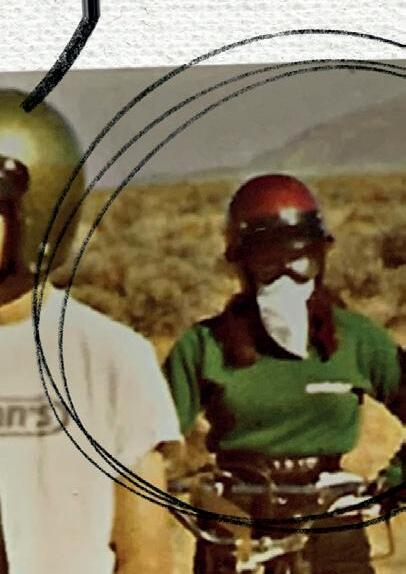



























































>>
famous Highway 1, the Pacific Coast Highway, as if it were yesterday. It’s easy to see why she became infatuated with bikes. It also became apparent that for the Sessions, motorcycles were a family affair.

Talking to Tammy, I loved finding out that in February 1975 she raced at the Portland Coliseum on her 360 Bultaco Astro, against an all-male field. Forty-five years later, in 2020, I raced my Indian Motorcycle hooligan on the same date, at the same venue, against an all-male field. I couldn’t have felt more welcome at the event. Now, as a woman racing flat track, my gender comes into it to such a small degree and I have women like Tammy to thank for that.












This is testament to the fact that Tammy is the real deal. As I started to learn more about her prior to her interview, I realised that she was one of the pioneering women of motorcycling in the ’70s. Racing flat track at that time, as a woman, was no easy feat. Tammy casts her mind back to the difficulties she faced. ‘You know, in the first instance I was actually denied a licence by the AMA, for no more reason than the fact that I was a girl! Which seems crazy to say out loud now, after everything I’ve gone and done.’







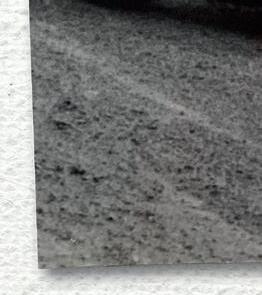

Prior to a 1971 Supreme Court ruling against the AMA, women could not hold a professional AMA flat track licence, nor were they even














permitted to be in the pits. Thanks to the hard work of Debbi Selden, who remains Tammy’s friend to this day, the participation of women in flat track was enabled. Still, it took tireless lobbying and a lawsuit filed by Selden, back in 1968. Imagine, three tough years of fighting for the right to race. As a woman racing today, it’s important to remember that era and those who have made it so easy for me to do what I love.







Once she was granted a licence, Tammy spent the next three years working her way up the Pro licence categories. She raced all over the States, competing in the Camel Pro Series while being sponsored by her father’s business, Fred Sessions

‘I ROCKED UP WITH HAIR DOWN TO MY WAIST, WEARING A BRIGHT PINK LEATHER SUIT AND STANDING ABOUT 5FT4IN TALL!’
health clubs, starting out on a 250 Ossa, progressing to a 360 Bultaco, and then to the Pro Junior class on a 750 Triumph, taking to the track in the pink leathers that caught our eye in the first photo we saw of her. ‘They were my favourite, and that Triumph was something special. People didn’t know what to think when I rocked up with hair down to my waist, wearing a bright pink leather suit and standing about 5ft4in tall!


‘I’d often get told, by spectators and competitors alike, that I didn’t belong at the racetrack, let alone on it, but I just let it go over my head. I was having a good time doing what I wanted and loved.’



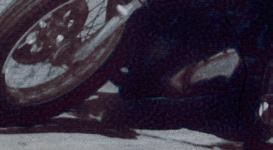
As she chased the races across the US, the welcomes only became colder, particularly as she reached middle




































America. Those state fair tracks didn’t know what had hit them, but Tammy recalls these memories as some of her funniest from the flat track trail. ‘Living on the road, chasing my dreams, encountering different people, surrounded by friends… Those were some good times.’
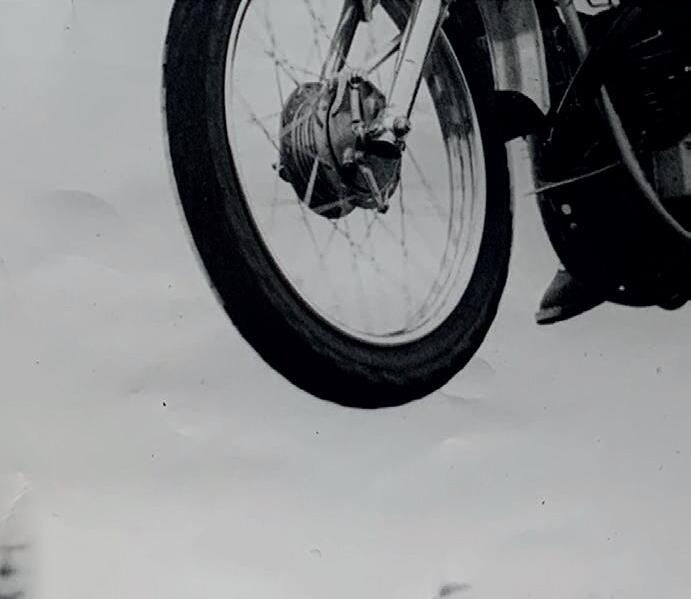
As a competitor during flat track’s heyday, she set her goal to make the main. Often competing against national numbers and hot local amateurs, Tammy enjoyed her fair share of success and had come a long way from her ‘powderpuff’ trophywinning days as a kid.
While racing, she worked in the family health spa business then, as time progressed, she turned her hand to truck driving. ‘It was ideal. I worked my way up there and ended up




















working a week on, a week off, allowing me to squeeze in plenty of adventures.’
Hailing from the Pacific Northwest, Tammy knows a lot of famous flat track faces. ‘JD Beach grew up in my neighbourhood and as a kid he’d often be bobbing around in my pool or egging me on to go to some moto camps with him. He’s so great and we always had a blast.’
Tammy did her last desert race aged 45, riding a punishing 70 miles. ‘I had nothing to prove to anyone, it was all for myself.’ She took second place, only four minutes behind the overall winner and clinching victory in the Ladies class for the last time. Everyone was surprised by her tenacity, and this final triumph complemented her 18 desert race wins perfectly.
>>
Although not racing anymore, Tammy still spends plenty of time out in the desert. No stranger to adventure, she says, ‘I’ve completed our own Baja route five times, riding with family and friends. We would start from San Felipe, Mexico, and zig-zag from east coast to west coast. Most rides averaged about 1200 miles. Our last ride was to La Paz, Mexico.’

Tammy and her sister, Jody, the one who wasn’t allowed to tour as a ten-year-old, remain incredibly close and ride thousands of miles in Baja together, but their last trip lasted 12 days and is known in the family as the ‘Trail of Tears’.


‘Oh man, it really was a total disaster, but one of the best experiences of my life. I can just remember two of the guys that were with us riding into a cow and flipping over the bars in total darkness. Then I reached a complete low point after running out of water, and I started to drink out of a cow trough. Gas stations that were there previously seemed to have vanished. No two trips to Baja are

ever the same and that’s what keeps us going back for more.’ Tammy then informs me that they’re planning their return and Papa Sessions is going too, at 90-something years old.













It sounds strange, but Tammy got me pumped for retirement (I know, I know, I’ve only just started my first fullt-ime job), but with the extra time she now has on her hands she is able to keep herself busy by giving back to the motorcycling community. Whether that be by serving on her many committees, helping to organise cross-country races, being President




of the Washington State Motorcycle Museum or teaching women how to ride, Tammy Sessions is still very much an active motorcyclist.




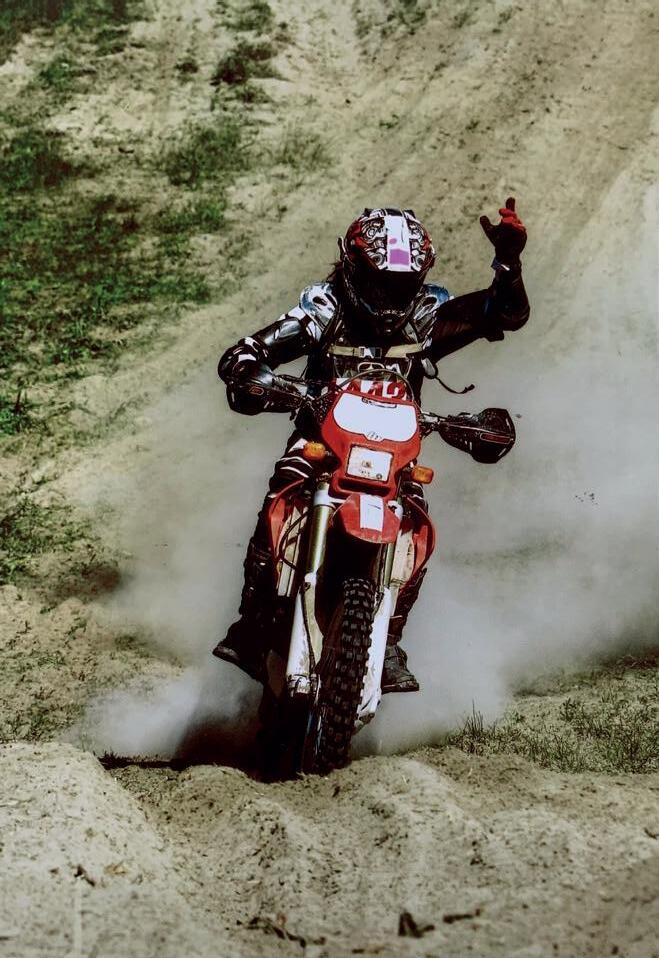
Our conversation left me full of energy, passion and enthusiasm. Tammy’s devotion to two wheels is infectious, and stretches across decades of massive change. She’s proof that motorcycles really can and do alter your life for the better. I cannot wait to hear all about her next adventure – and there will be more, because there are absolutely no signs that she’s slowing down.


project bike
Todd Marella introduces us to his 250 Vintage class Yamaha
It’s just a leopard, right? In the animal kingdom, this is true. In the world of purpose-built flat track frames… Oh, it’ll make sense later.


The bike is a ’74 Yamaha MX250 that has been de-raked and plugged1, which lowers the cradle and engine, and thus the centre of gravity, by 1.5in (38mm). It came into my life one day while sitting at the counter in See See, Portland, OR. Thor and Tori were there, and suddenly, as if prompted, Thor says to me, ‘Todd, you need a bigger race bike.’ Never a truer statement had he made to me at that point in our friendship. Until then, I’d been riding my first race bike, a 1975 RD200 shoehorned into a TS125 frame. It was all the power I needed for my introduction to the sport, but I looked like a Shriner in parade formation on a minibike.
‘I don’t want to sell my first flat tracker, but I’ll sell it to you,’ said
cylinder and caliper. Just needs a new top end and you’re ready to rip!’ How could I say no?
I took it home, and with the help of my friend Korry [whose bike was on the cover of SB41] and my neighbour Steve, an old Sidewinders2 racer from back in the day, had it torn down to the frame in an hour. I rolled my sleeves up and got to work stripping paint from tank and frame, and enlisted Casey at Cycle Heap to rebuild the motor. I envisioned the pipe that came with it – stock, cut in two and rewelded – fashioned as a down pipe, in white, with the mantra ‘white pipes save lives’. So it was.
The build was just in time for Dirt Quake, with nothing to spare. It was a rushed job on all fronts, with too little attention paid to the bottom end, specifically the big-end bearing. The bike seized in my heat race, and was done for the weekend.
this bike, it was my friend’s.’ I asked him how he knew, and that’s when he told me he noticed right away by looking at the frame modifications.
Thor. I was honoured, and sold – hook, line, and sinker. ‘I’ll sell it to you on one condition, that is, you sell it back to me when you’re done with it.’ ‘Deal,’ I earnestly, if blindly replied.

We walked across the street to the shed and dug the Yamaha out of the sea of bikes stored inside. He ran down the list of fitted components. ‘It has an original Barnes quickchange rear hub, laced to an old high-shouldered Borrani rim; Akront equivalent up front; the frame is all set up; a Golden flat track tyre on the rear, and Shinko up front, and an original Hurst Airheart master
Fast-forward a couple of years, a balanced crank and complete rebuild, a new bespoke expansion chamber, seven broken ribs, a broken ankle, and a handful of second- and thirdplace trophies, and this is where the story gets interesting. On my second trip to Spokane, WA, to race with pals from the Heap on a cushion track, between practice and heats I notice a guy looking intently at 73Q. I introduce myself as the owner and he says, ‘I know
‘Those welds, that gusset around the neck, and that steel peg mount… those are the work of Led Szmek. He built two of these frames, and I had the other.’ Yes, that Led Szmek, of Panther Frames3 fame. When I had loaded the bike for Spokane it was just a reworked stock Yamaha. When I loaded it for home, it was a Panther. The guy who ‘spotted’ my Panther is John Clayton, still racing, still ripping. The bike in its present state makes great power thanks to a top end by a guy who builds motors for 1000hp four-cylinder drift cars; a 38mm Mikuni roundslide; a very early expansion chamber by Gary Braun at Retrodyne and a replacement silencer by Erick Navetta. It’s shod with the latest Mitas tyres, the custom seat glass is Korry’s that he built for his first MX250, upholstered by Roxan at Range Needlework. The Hurst Airheart caliper has been replaced with a dual-piston Brembo originally found on the front of a Ducati street bike. By time of printing, the Hurst master cylinder will have been replaced by the one I got from Jack Warren at First Klass Glass in today’s mail. All custom fabrication performed on the bike since I bought it is by Chris DeSanty, and to him and all my other flat track friends, I am eternally grateful.
I’ll sell the bike back to Thor one day, but it’ll cost him. It’s a Panther, after all. Dig.
Photos: Scott Rounds
APPENDIX: 1. ‘Plugging’ is where the frame’s downtubes are cut and extended, lowering the bottom frame rails and the engine.
2. Historic Pacific North West motorcycle racing club. 3. Read about a Panther Honda XL350 in SB27.
CONTACTS CycleHeap.com @RangeNeedlework @Retrodyne SeeSeeMotorcycles.com
‘I looked like a Shriner in parade formation on a minibike’








99

2019にFANTIC JAPAN と HAVE FUN !! の合同プロ ジェクトで完成したアイスブ ルーレーサー500(ベースは CABALLERO FT500)
その後こいつは傷つかないよ う軽くテスト走行はしたもの のおもに各地のイベント、展 示会へ出向き
いろいろな方々に見ていただ き大切にされてきた。
2021、ついにアイスブルーレ ーサーのネクストプロジェク トがスタート
内容は簡単、コイツをレースコ ースでガンガンに乗り倒す! HAVE FUN !!が作ったのはFT レーサー、飾って眺めて酒の つまみにする物ではあらず。
跳ね石のによる小傷、エキゾ ーストについた泥の焼け跡、 ニーグリップによるタンクペ イントの曇り
そしてFT特有の片側だけスラ イドにより変摩耗したタイヤ これらがそろってアイスブル ーレーサーは完成する。
担当のライダーは泣く子も
黙る日本のペイント 界の大御所 Shakin`
SPEED GRAPHIX の清 水氏。
彼が現在サポートを受 けるSPEED.STYLE.
GOODTIMES カリフォルニア 生まれのMX&MTBアパレル ブランド

FASTHOUSE JP のウェアを
身にまといアイスブルーを惜 しげもなくオーバルで乗り倒
FANTIC & HAVE FUN!! ICE BLUE RACER PROJECT EPISODE 2 START!!
す姿に注目されたし!
Photo by URIBOU
Ice Blue Racer 500 (based on Caballero FT500) completed in 2019 as a joint project of Fantic Japan and HAVE FUN!! After that, although it did a light test run so as not to hurt it, the bike went to various events and exhibitions and was cherished by various people. In 2021, the next stage of Ice Blue Racer is finally started. The idea is to have fun with this bike on the race track! HAVE FUN!! made an FT racer, not decoration. Small scratches caused by stones, mud, burn marks on the exhaust, cloudy tank paint due to knee grips, and tyres that have been distorted due to sliding on only one side, peculiar to FT. The rider in charge is Mr. Shimizu of Shakin’ Speed Graphix, a major figure in the Japanese paint world who keeps the crying child silent. SPEED.STYLE.GOODTIMES California-born MX & MTB apparel brand he currently supports. Attention was paid to the appearance of wearing FASTHOUSE JP clothing and generously riding Ice Blue on an oval!
101
The Right Stuff
Trusted: The
2020
American Flat Track Production Twins
champ and world championship road racer James Rispoli shows us the race essentials he wouldn’t be without
1 Arai helmet
I usually have three helmets with me at all times, just in case we need a quick change. I also have a few different visors…
2 Visors I try and have a few new visors prepped with tear-offs, so all I need to do is change a visor and not prep anything at the track.
3 Microfibre Just to give the helmet a little taster before going out for the main event.
4 Charger and cable To recharge the A-Star airbag suit AFT demand that all racers compete in airbagequipped leathers at every race now.
5 Tear-offs I use two different styles. A road-race style, which is way thicker for the groove/car tracks, and a laminated set for the cushion tracks.
6 Alpinestars booties Very comfy inner booties for my boots.
7 Alpinestars gloves 1 A mesh glove used for TT tracks and small short tracks.
pearly white Supertech Rs I absolutely love these boots.
11 4SR custom kangaroo suit
This is 4SR’s brand new race suit they launched exclusively for dirt track. We have developed everything around DT, down to heat shields for the exhausts.

12 Steel shoes Both from West Coast Hot Shoes, pre-painted for the next race. These things take a beating and you need something that’s going to last a season.
13 Defy All Odds hat To keep the hair tame.
14 Massage drill Having had a few injuries over the years, I use the drill in between sessions and pre-race to make sure everything is nice and loose.
15 Hammer Bar I am a snacker during the day and having a nice nutrition bar that fills you up and that tastes great is always a good thing to have around.
16 Coffee UnTapped This is coffee-infused Vermont maple syrup. I usually take one before the main for a nice boost and to make sure I have enough energy for the race.
Name: James Rispoli
Age: 29
Job: Professional motorcycle racer
Hometown: Londonderry, NH
Bikes owned: 1990s Knight Rotax 670; 2001 C&J Honda CR85; 2002 C&J Honda CR250; 2002 C&J Honda CRF450; 2019 KTM 450; 2020 Harley-Davidson XG750R
8 Alpinestars gloves 2 Leather road-race glove for half-mile and mile tracks. I’ve half lost a pinkie already and don’t intend to lose another.
9 Alpinestars socks Spares in case we step in a puddle.
10 Alpinestars boots A fresh set of
17 Hanger/dryer We usually race in scorching hot conditions so it’s nice to have a hanger that has a fan inside, to make the suit a bit fresher between sessions
18 Dude Wipes Well, dude, you just never know when you will need a wipe.
Photo: American Flat Track

1 2 3 4 5 7 8 9 6 10 11 12 13 14 15 16 17 18 103




Panther
Limited-edition designs, like this one by Dave Tharoofer, and well-loved classics are regularly added to our shop. T-shirts, sweatshirts, caps and hats, pocket money pin badges, rare back issues, race day essentials and collectible books, too Shipped internationally Visit Sideburn.bigcartel.com
Cross
From: Jose ‘Hozer’ Aguilar
To: sideburnmag@gmail.com
Date: 23 April 2021



Subject: San Jose 1992
SB: Hi Jose. We’ve got this great photo of you on the podium after the Junior race at the San Jose Mile in 1992. You’re there with Allon McBee on the top step and Jeff Eklund. What can you remember about that race?

JA: That McBee had a cheater motor LOL. I beat one one of my best friends for third, Cory Perreault, 7y. Cory was like, I can’t believe you beat me at my hometown race! He was all bitter LOL.
SB: What bike were you on?
JA: I was on my Wood Rotax built by Dave Bird.
SB: The raised, clenched fist is a pretty strong image. What was behind that?
JA: Just for the fans. It’s always about the fans for me.
SB: Did you enjoy racing at San Jose?
JA: Yes, San Jose was one of my favourite tracks to race at, plus it was home. I had a lot of family and friends on the stands.
SB: Was the lucky horseshoe on your leathers a thing of yours? What’s the significance of the circle in the middle of it?
JA: That was for a man by the name of Mike Macedo, that was his brand. Mike was the guy who got me started in racing.
SB: What memories does this photo bring back?
JA: Just being a part of the flat track family. And all the traveling.
SB: Thanks Hozer.
JA: Aye, if I make it in the magazine, I want a copy!
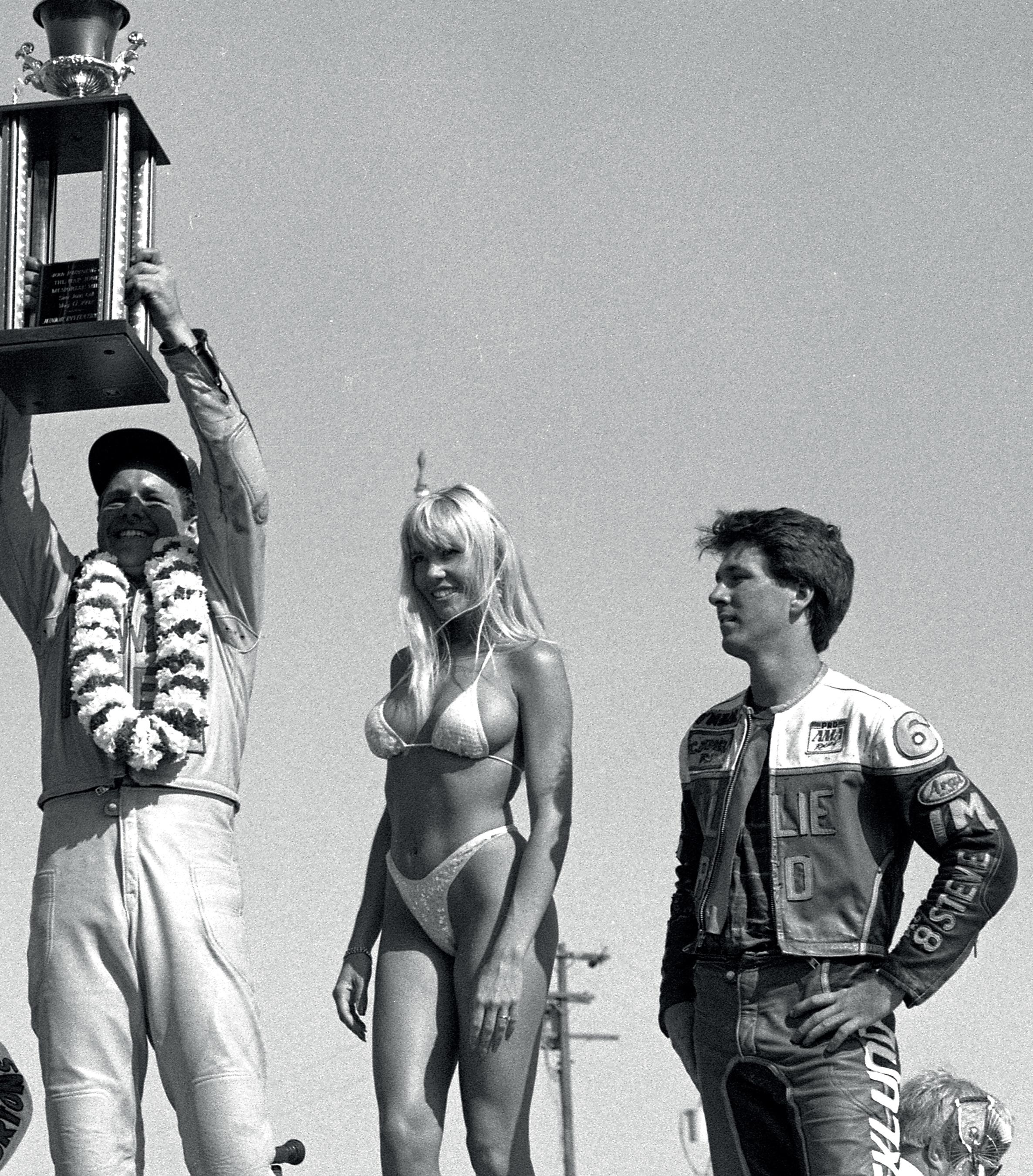
107

www.sideburnmagazine.com